This is a compilation of the designer diary entries posted in the Red Rising Facebook group. They are listed here in chronological order, with the most recent entry at the top.
***
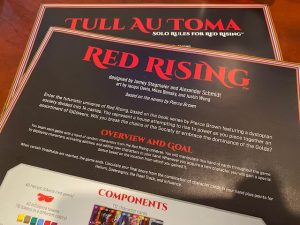 February 17: Rulebooks, Watch It Played, ACLU, and Preorder Date
February 17: Rulebooks, Watch It Played, ACLU, and Preorder Date
Thank you for joining me over the last 2 weeks as I’ve revealed the Red Rising game. You’ll start to see reviews next week (February 22), followed by a a digital demo available on Tabletopia on March 1, then the preorder on the morning of March 3 (around 10:00 am CT). We expect to receive and to start to ship games to preorder customers in early April (maybe a little earlier, maybe a little later–it all depends on freight shipping to our fulfillment centers in the US, UK, Canada, and Australia).
Thanks to everyone who signed up for a preorder launch notification, this morning Stonemaier Games will be making a donation of $10,724 to the ACLU! I’m really excited about that.
Both the core rulebook and the solo rulebook now are available for you to download and read here.
And thanks to the craftmanship of Rodney at Watch It Played, a rules replacement video is available for you to watch here:
If you have any rules questions, please let me know!
February 16: Silvers, Math, and the Scorepad
Today I’m revealing the 14th and final color in Red Rising. Silver characters are right near the top of the Society pyramid, just under Golds. They’re the financiers of the world–they own and run corporations.
In Red Rising, helium-3 fuels the world’s spaceships, terraforming, and megacities. It’s the currency of the future. So Silver characters in the game can often spend helium during their deploy actions, and they often care about amassing helium for end-game scoring. Here are a few of them, including Quicksilver himself.

You may have noticed through all of these card samples I’ve showcased over the last few weeks that we tried to use numbers that can easily be added (or subtracted). This often means the points are in denominations of 5, though sometimes they’re formatted like the CEO (they become a denomination of 5 when added together). We did this to make quick in-game math and end-game calculations a bit easier.
Of course, you may still want to pull out your phone calculators when you get to end-game scoring. We include a 50-page, double-sided score pad in the game. It’s good for 100 six-player games (or 200 three-player games, or 300 two-player games). The scorepad is exactly the same in both versions of Red Rising.
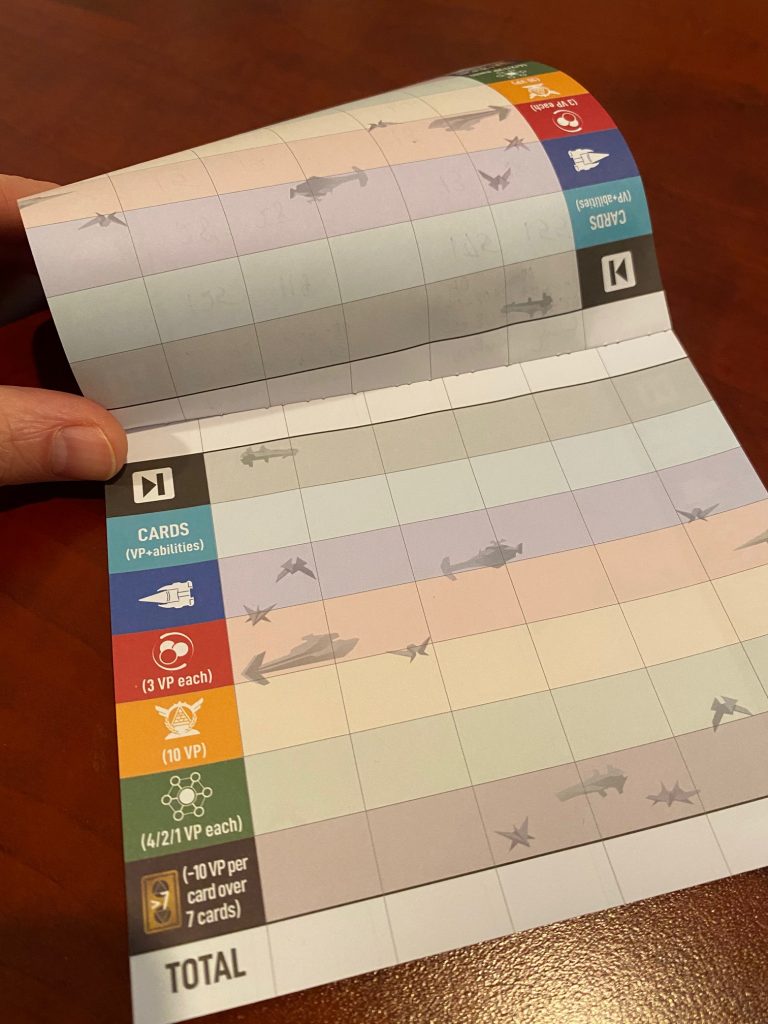
Tomorrow’s final reveal will include links to the rulebooks, the Watch It Played video, the ACLU donation total ($1 for each preorder launch notification signup), and the exact date/time for the preorder.
February 15: Browns, Reference Cards, and the Teaser Trailer Debut
Today I’m really excited to share with you the teaser trailer for our Red Rising game. Before I get to that, I’d like to introduce you to a few Brown characters, who occupy the “assistant” caste in Red Rising.
As assistants, Brown characters seek to help (i.e., be deployed directly on top of) a specific type of character. In doing so, they move that character to another location (making it available for you to gain) and give you a bonus. Like many other deploy abilities, Browns are all about timing.
At the end of the game, Brown characters seek to be with those same colors. So if you can build a hand of Silvers, Whites, and Coppers with the Nanny, you could end up with quite a few points.

One of the last few components I haven’t revealed are the double-sided reference cards. I like reference cards where you really only need one side of the card during the game (if at all)–that’s the turn overview/iconology side. You can refer to the setup/end-of-game side at the beginning and end of the game. These cards should also help to teach the game, as everything a new player needs to know is on their reference card.
This brings the final total to 123 big cards (65x100mm) and 25 small cards (57x87mm) in Red Rising. While the insert and card holders are designed to fit sleeved and unsleeved cards, we don’t necessarily recommend sleeving these cards. You only shuffle once per game (minimizing wear and tear), the cards are made from durable linen-embossed ivorycore, and the reflective nature of sleeved cards may impede your ability to see icons/text from across the table. Also, if some of your cards get worn down after hundreds of plays, just fill out our replacement parts form and we’ll help out with those cards.

Finally, here is the teaser trailer, making its debut on YouTube right now!
February 14: Pinks, The Jackal, and Setup
Happy Valentine’s Day! For today’s brief design diary, I thought it would be timely to introduce some Pink characters. Pinks are the companions of the world of Red Rising, but don’t be fooled by their beauty–there is a dark history under the surface of each of them.
Most Pink character cards have abilities similar to Matteo’s (move any card from Matteo’s location to the top of another location, making it accessible for you to select; if it’s a specific color, gain a bonus), but a few Pinks–like Evey and Calliope–vary based on their specific characters.
As companions, Pinks gain points if they’re with specific characters at the end of the game.
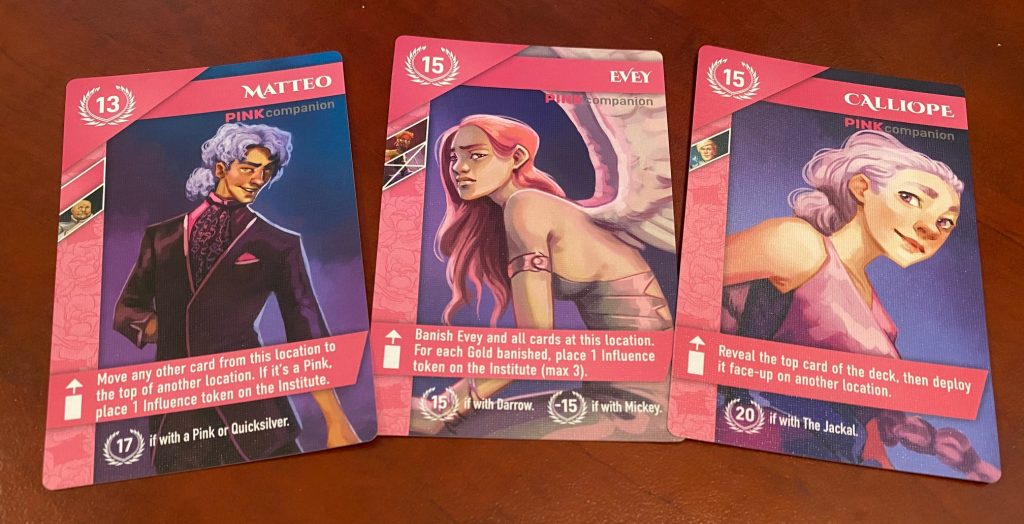
Calliope specifically wants to be in your hand with The Jackal, so I thought it would be a good time to showcase one of the more infamous characters in Red Rising:
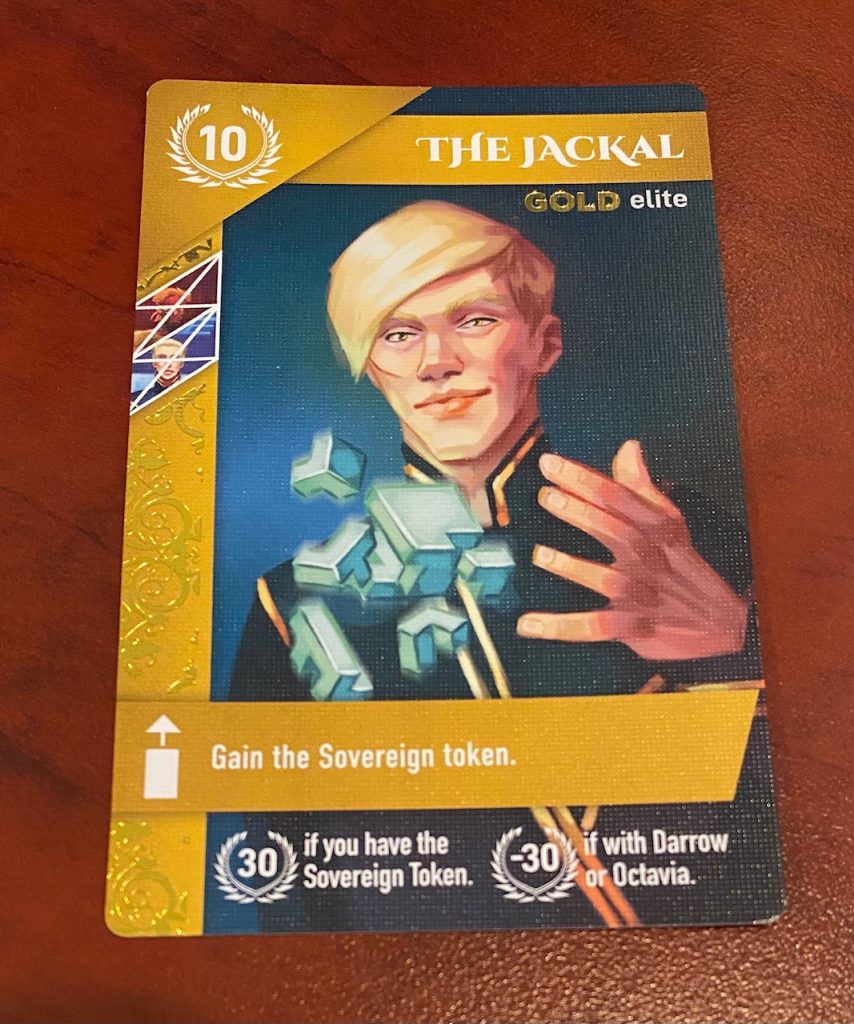
Last, I realized I hadn’t mentioned setup! We tried to keep setup as streamlined as possible–basically just hand out Houses and player tokens, shuffle the deck, and go.
But there’s one element that’s distinctly different from the game that inspired Red Rising, Fantasy Realms. In Red Rising, we found that the game works much better if the locations are seeded with a few character cards at the beginning of the game so you’re not just blindly drawing from the deck for a few turns. So one of the first things you do in setup is to place 2 random character cards face up on each location. Why 2? 1 seemed like too few, and 3 presented the possibility for information overload.
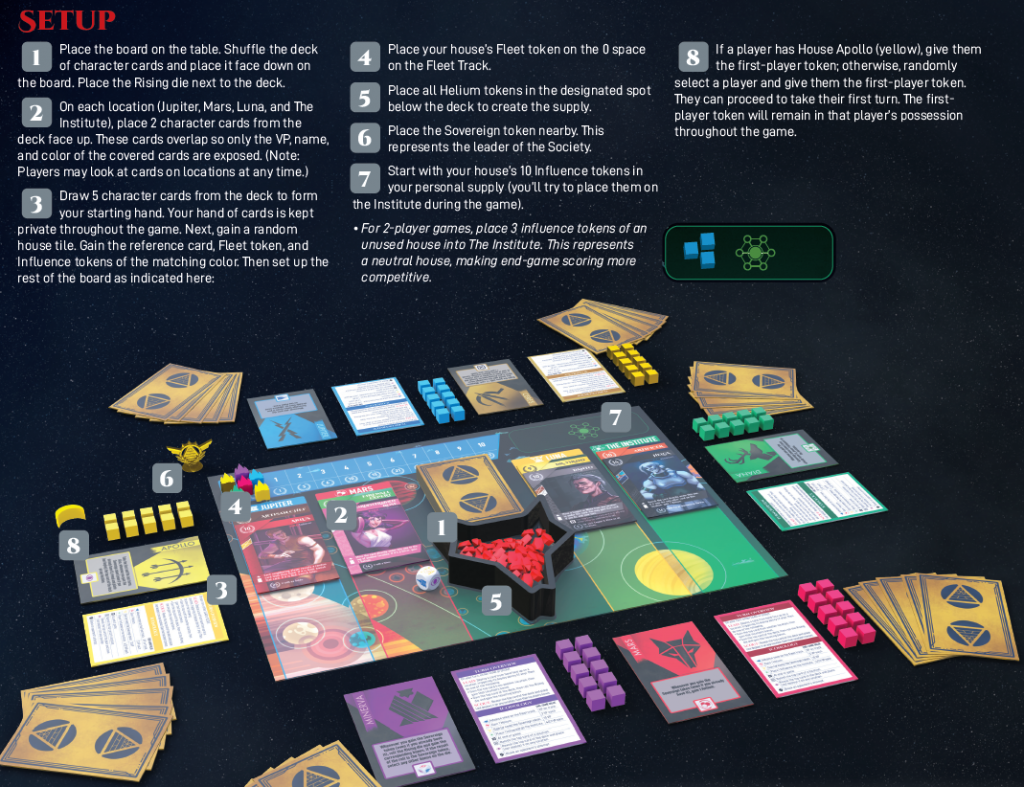
I’ll be back tomorrow with the teaser trailer for Red Rising!
February 13: Finding the Right Card with Oranges and Grays
During the blind playtesting process, we started to hear a piece of feedback that I don’t often hear as a publisher: “I wish there were fewer cards.”
Honestly, we were very hesitant to change the number of cards, as something just felt right of having 7 cards in each color and 21 golds (112 total character cards). So we dug deeper, and we learned that the issue wasn’t “too many cards”; it was, “I have a card that pairs with another specific card, and I feel like the odds of seeing that character in this big deck are super low.”
The big deck of cards is great for replayability, as you’ll only see a portion of it each game. But it now made sense why some playtesters were daunted by it. The solution we found involved two colors, each with a similar end-game ability.
Oranges serve a few purposes as the engineers of the Society; we use them to showcase some of the tools and weaponry found in Red Rising. When you deploy an Orange, you can gain a specific type of card anywhere on its location (not just the top card). So if Mustang gets buried under a pile of cards and you have the Gravboot Cobbler, you can use it to bring Mustang into your hand.
At the end of the game, the Gravboot Cobbler has this ability: “You may treat this card as having the same name as any specific character.” So if you have a card that really wants to be with Cassius–but Cassius is somewhere in the middle of the deck–you can treat those gravboots as if they have Cassius’ name for that end-game combo. We thought this made thematic sense because anyone can wear gravboots. You can only use this at the end of the game, and each Orange can only have one modified name.
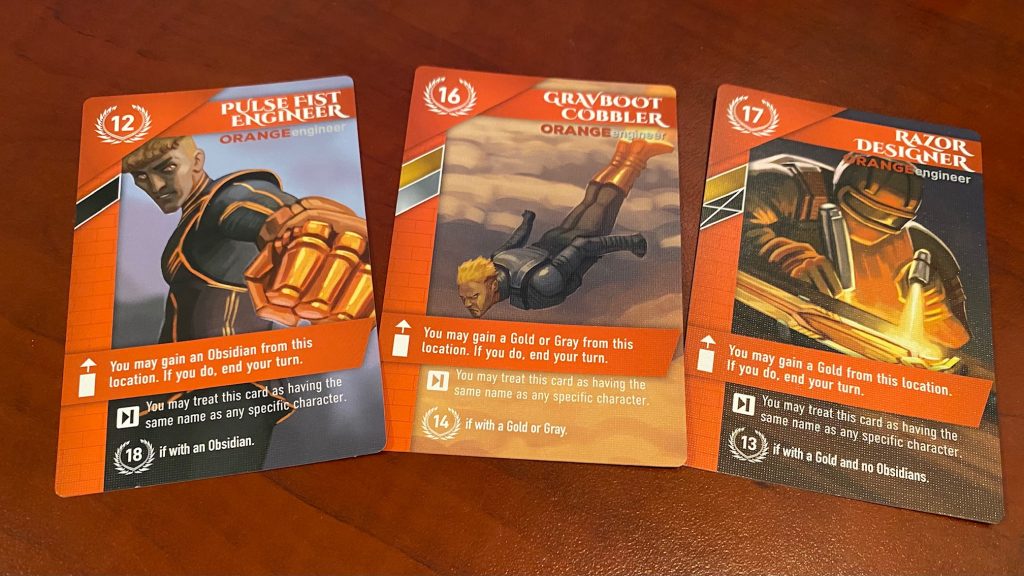
Grays also serve an important role in this solution. Grays are the security forces of the world, and their deploy abilities let you “imprison” any card on a location (again, not just the top card) under the gray. You can then either gain the card or simply leave it there (wresting it from the reach of an eager opponent). Grays also look at cards on the board at the end of the game to score extra points (e.g., Colonel Valentin gains 5 VP for each Gold on all locations).
A the end of the game, you may treat each Gray character as if it is any one other color (in addition to Gray). So if you have a card that wants to be with a Blue but you either can’t get a Blue character or you can’t find a Blue character that combos well, you can simply declare one of your Gray cards as Blue too.
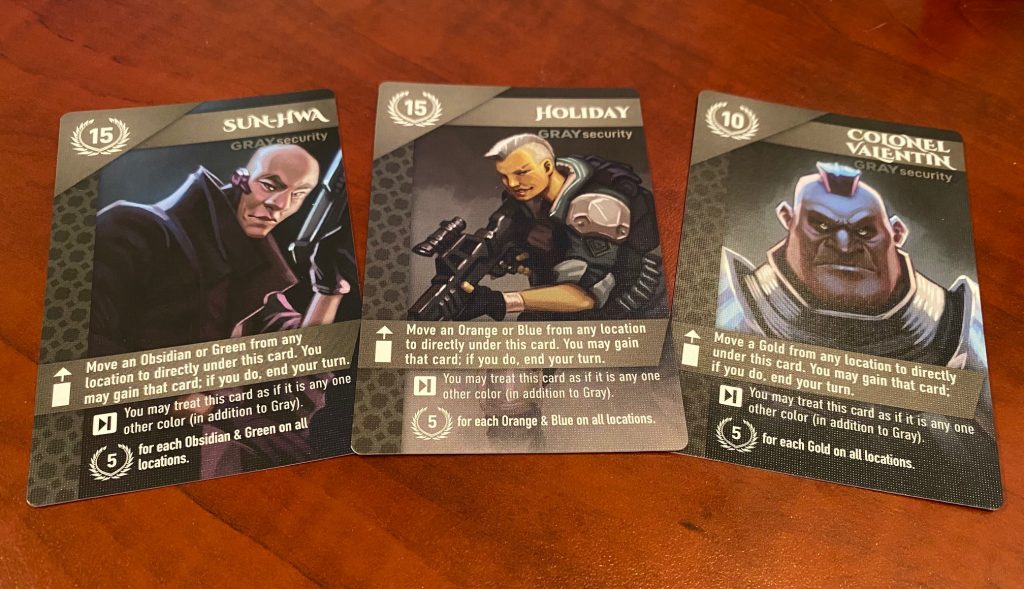
Note that one solution we intentionally did not implement is the ability to search through the deck for a specific card. This would have interrupted the flow of the game as all other players waited for you to find that card and then reshuffle the deck. One of the nice things about Red Rising is that you only shuffle the deck at the beginning of the game.
Two colors today! I have a few more remaining, along with the teaser trailer, the rulebook reveal, and the Watch It Played video over the next few days.
Also, there are now Red Rising house microbadges available on BoardGameGeek! https://www.boardgamegeek.com/thread/2600863/article/36995761
February 12: Blues, Fleets, and Automa
I’ve mentioned how the different colors in Red Rising are genetically engineered, but perhaps no color is altered more than the Blues. Blues are implanted with technology that allows them to control spaceships and other massive vessels.
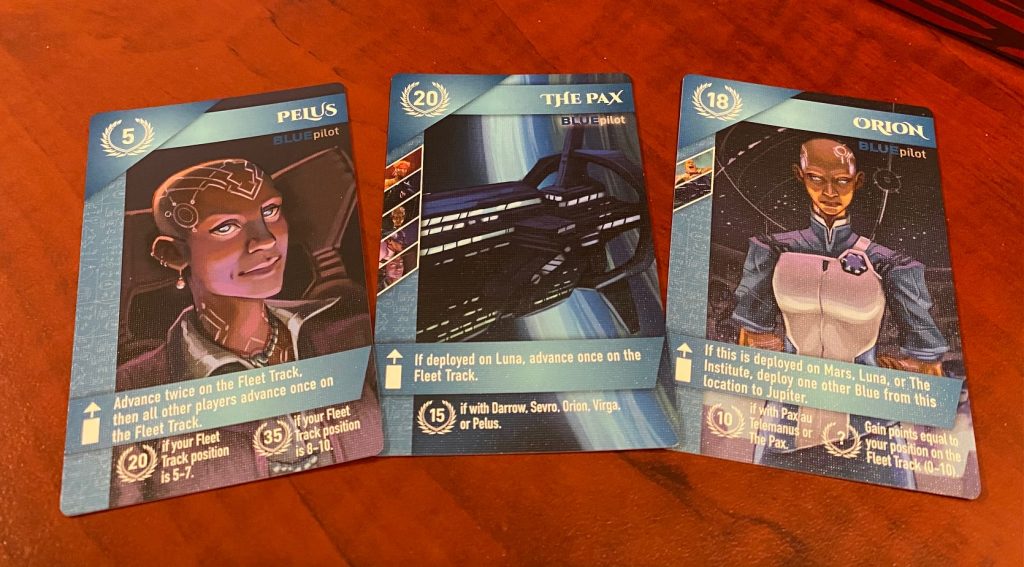
We wanted to showcase some memorable Blue characters in addition to specific ships on the Blue cards, especially given how closely connected the ships are to the Blues themselves. Blues primary help you advance on the Fleet Track, and they typically offer end-game points based on the your position on the Fleet Track.
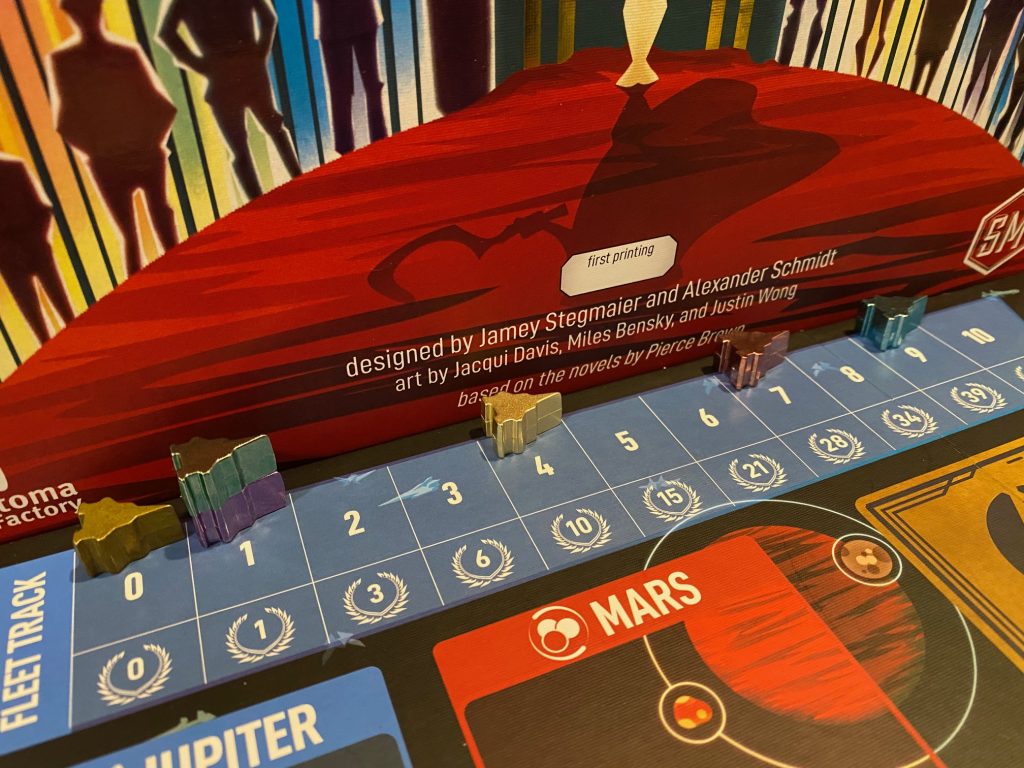
The Fleet Track itself is a bit of an abstraction, as it represents the size and prowess of your fleet. As with many things in the Red Rising game, 7 is the sweet spot: Points incrementally increase leading up to that space, and then they start to incrementally decrease.
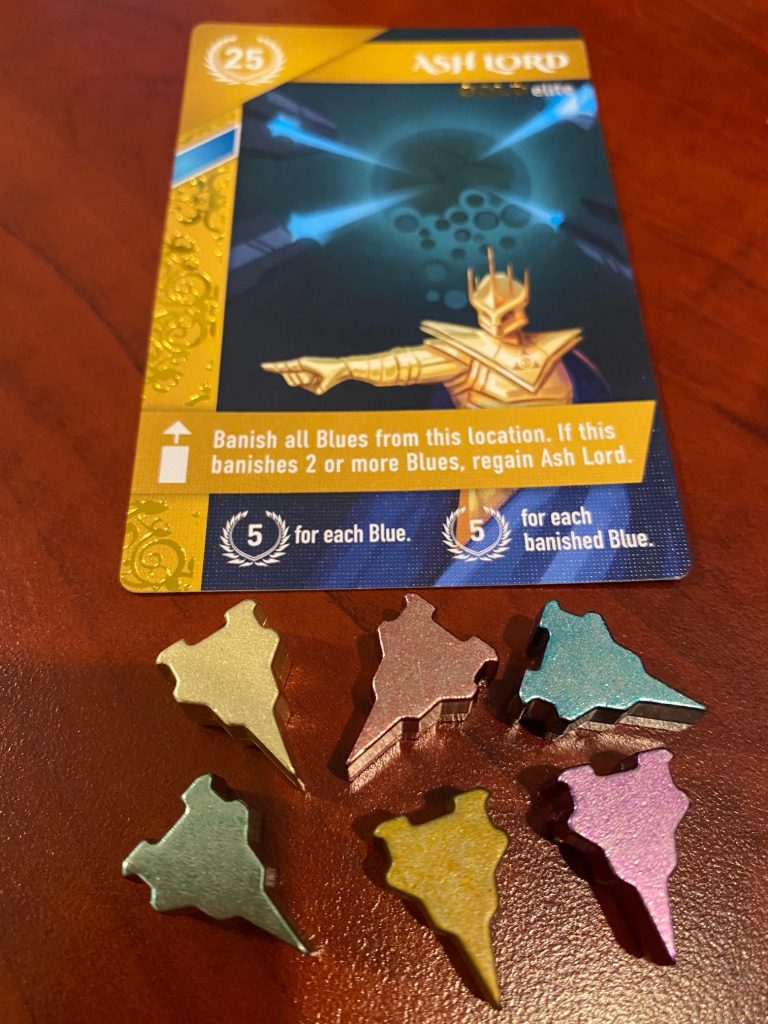
Even though Blues control spaceships, it’s Golds who captain them. So there are a few Golds–like the powerful Ash Lord–who care specifically about Blues and/or the Fleet Track.
Now for something special! Morten Monrad Pedersen is going to take over for the rest of the post to describe the Automa solo mode in Red Rising, which includes 30 cards specifically designed for solo play.
Going for mental butter
Do you have a memory like a broken toothbrush? Do you want to keep all game information in your head while playing games? If you answered yes to both questions, then you’re like me and I can tell you that your mental bandwidth will be challenged by Red Rising because there are a lot of card abilities to consider at any one time.
In solo, you have the advantage that you can take as much time as you want to juggle it all, because Tull Au Toma (the game’s artificial opponent) won’t complain if your turn is taking too long.
On the other hand, the solo mode has the disadvantage that you need to perform the turn of Tull Au Toma which can make you forget some of the card abilities that you just read.
Because of this we decided that Au Toma’s rules would have to be so buttery smooth that her turns would slide right by with minimal extra mental load and to create this mental butter, we had to focus even more on simplicity than we usually do.
Be prepared
When Jamey first told my co-designer David and I about the Red Rising game he mentioned that it was it had significant similarities to Fantasy Realms from WizKids. So, in preparation I bought that game and designed a prototype Automa for it.
Once Red Rising was ready for us, I ported the Automa from Fantasy Realms and I was happy about the prototype I made, but the result was:
Thud, thud, thud, thud…
The sounds of faces hitting the wall as my team and I slipped in mental butter gone sour. Luckily, Stonemaier has awesome health insurance, so we got our faces put back together.
What worked in the simple game, Fantasy Realms, became too unwieldy for our requirements when ported to the more complex game, Red Rising.
And they have a plan
One of the core mechanisms of the Fantasy Realms Automa was what I called a “plan”. It consisted of a set of card suits that Automa wanted that was gradually constructed as the game went along.
Fantasy Realms has 10 suits which was pushing it in relation to the player having to juggle them to check for which cards to pick based on the plan. Red Rising took the number of suits (colors in this case) to 14 and that pushed the plan system beyond the breaking point. This was one of the main reasons why the initial version of Tull Au Toma was unwieldy.
So, we removed the plan system, but we liked the idea of it having a strategy that the player could include in their strategizing and therefore we instead made a system that was based on the locations on the board, which took us from the unwieldiness of 14 suits to the wieldiness of 4 locations.
Getting there was quite a journey from the initial work on the Fantasy Realms Automa to version 4.24.19 of Tull Au Toma, but in the end we got an opponent that contained the elements we wanted while being so simple that the rules used while you play (i.e. between setup and scoring) take up less than a page and a half as seen in the picture.
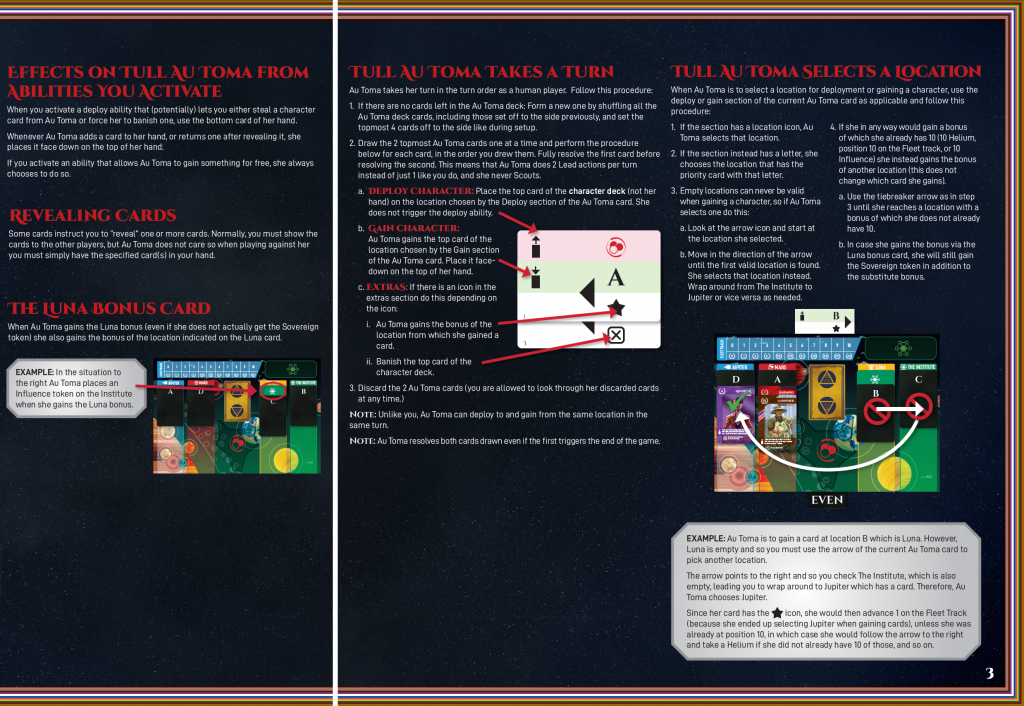
Thanks Morten! If you have any questions about the solo mode, feel free to ask in the comments.
February 11: Blocking, White Characters, and Hand Size
Over the last week I’ve mentioned a number of different reasons that players need to pay attention to each other and can impact each other, directly or indirectly:
- end game triggers
- specific characters (direct)
- specific characters (indirect)
- influence
- where to play characters
- which characters to deploy
- which characters to pick up
- table talk alliances/deals
There’s one last icon/ability related to some of these interactions that I haven’t explained. The “block” icon is most commonly found on the White characters in the game (remember that colors in Red Rising represent genetically-engineered castes–“White” in the Society is not the same as “Caucasian” in the real world).
If you have a card with a “block” icon, you may reveal that card at various times to protect yourself. For example, if you have the Justice, he says, “You may reveal this whenever an opponent tries to take the Sovereign token from you. If you do, banish this card to keep the token, then gain the top card of the deck.
While there aren’t many characters in Red Rising that steal or banish cards for a specific opponent, you can hold onto the Justice during the game to protect yourself. If a card has a “block” ability, it does not also have a “deploy” ability (you can deploy it, but you don’t get a deploy benefit).
As the arbitrators of the Red Rising world, White characters often care about the Sovereign token, both in terms of their end-game abilities and in-game abilities.

While it’s mostly White characters who have the block icon, it appears on a few others, including one of my favorites, Pax au Telemanus:
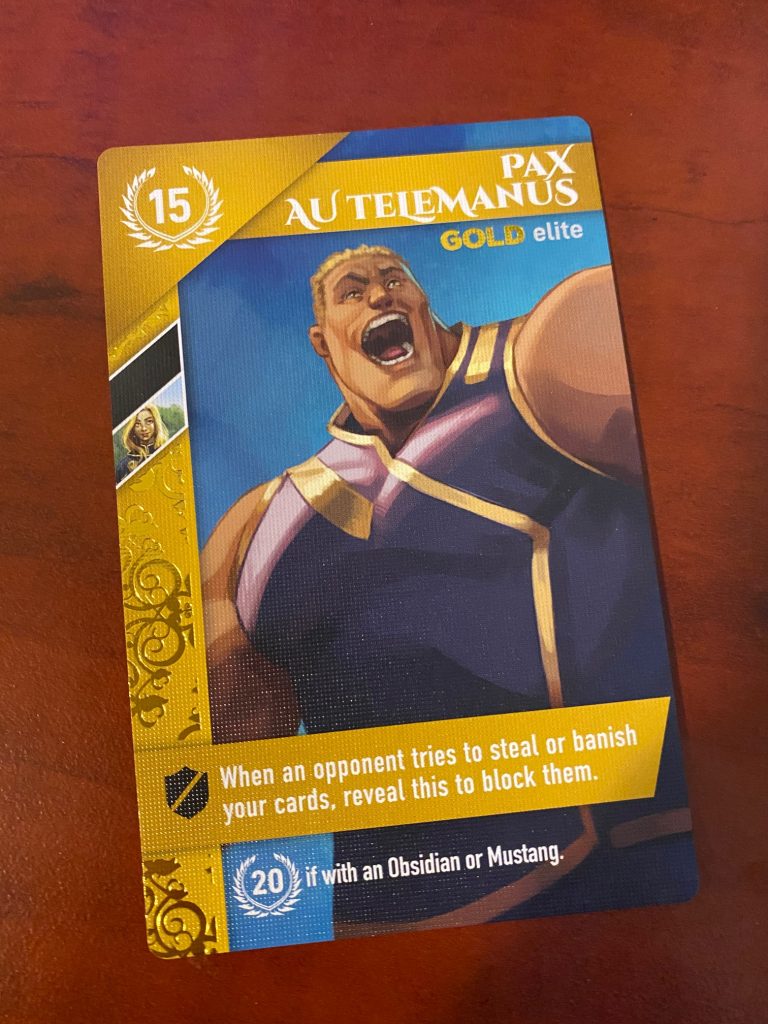
You may have noticed that there are several cards in the game that give you extra cards. There are a few design-related decisions we made about this aspect of Red Rising.
The first is your starting hand, which is 5 cards. Originally it was 7, as 7 is our go-to number in Red Rising for end-game triggers. However, 7 is a surprisingly daunting number of cards to be presented with at the beginning of the game, so we eventually decided to decrease it to 5.
Later in playtesting, we found that some playtesters were focusing almost solely on gaining extra cards. It can certainly be a good decision in many cases, but the data indicated the larger hands almost always won.
We considered a hand limit, but we instead found a more organic solution: At the end of the game, if you have more than 7 cards, you’ll lose 10 points for each of those cards. So, if you somehow have 9 cards in hand at the end of the game, after scoring all of those cards, you’ll lose 20 VP.
This not only changes the value proposition from blindly gaining extra cards; it adds a psychological barrier at 7 cards. It feels great to have exactly 7 cards, especially if they combo well. It still doesn’t mean more cards are better, though–Megan beat me the other day with a superb 5-card hand even though I had a pretty good hand of 7 cards.
If you have any questions about this post or others, feel free to let me know! And if you haven’t already signed up for a preorder launch notification, please do so here (https://stonemaiergames.com/games/red-rising/). For every email we receive by February 16, we’re donating $1 to the ACLU. We’re currently up to a total donation of $9,487!
February 10: Graphic Design, Colorblind Friendly, Board Layout, and Purples
One of the biggest challenges in a game with multi-use cards is how much information to include on the card and how to convey that information. Fortunately, we have a very talented graphic designer, Christine, who was up for the challenge.
The image here goes into detail about various elements and icons on the cards, all of which are 65×100. That’s bigger than standard cards, as we wanted plenty of space to feature the art, text, and icons. It’s the same size of cards as in 7 Wonders, though, so there are sleeve options out there (though the cards feel great to shuffle without sleeves, especially with the linen embossing).
One element on the cards to highlight is that because Red Rising is a game about 14 different colors, we wanted to make the cards colorblind friendly. So there are four ways you can tell the color of a character card:
- The actual color of the border
- The color word under the character’s name
- The unique pattern in the left sidebar
- The art direction for the character themselves
We considered also adding an icon for each color, as such icons exist in the world of Red Rising, but icon overload is a problem too, so we decided not to include them.
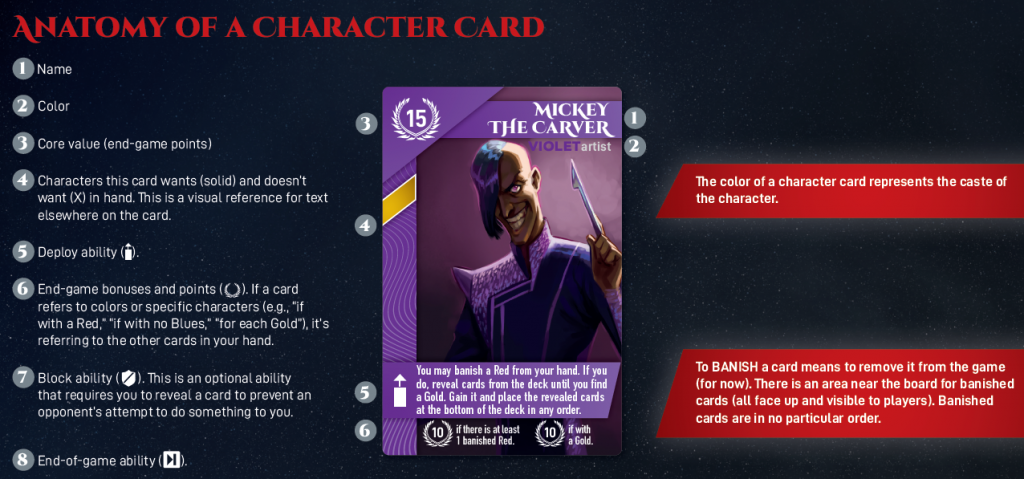
Because we used unpainted metal to give it a more quality look than painted metal, some of the metal tokens are fairly similar and are not colorblind friendly, but your tokens have very little interaction with opponent tokens, so it’s not really a factor. When you place influence cubes on the Institute, stack them in a little pile that is distinctly yours. On the Fleet track, you only have one token to keep track of, so I haven’t found it difficult to remember which token is mine (and if you do, you could put an Influence token on your fleet token to differentiate it). We won’t be offering plastic cubes ala cart, but cubes (wooden or plastic) are easy to buy from companies like Meeplesource.
The other element of the character cards I haven’t mentioned are the banners in the left sidebar. The idea here is to convey the types of cards and specific characters that your character does or doesn’t want to share your hand with. This information is on the left so you can see it when you fan cards in hand, and it helps players see from across the table the core aspects of characters on various locations.
Antonia, for example, wants to be with Golds and The Jackal, and she doesn’t want to be with Victra or Sevro. The order of the sidebars are always color first, then specific characters.
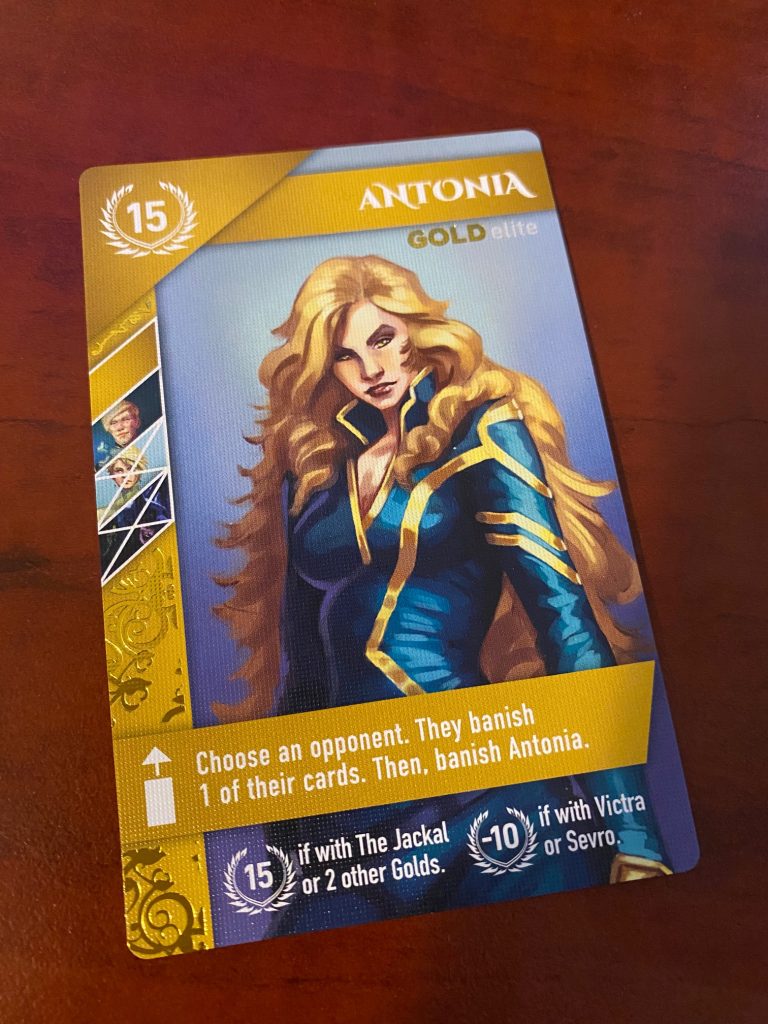
The other big challenge with layout was the board itself. Even with the icons on cards, there are many times when you’ll want to read the text on a card before deciding to gain it. We experimented with a number of different board formats, including one where the locations extended in opposite directions and a round board where locations extended in four different directions.
In the end, we realized that it was better to have SOME players looking at the cards upside down than to have ALL players looking at some of the cards upside down. You can pick up a card from a board at any time to read it, as long as you put it back in the same order.
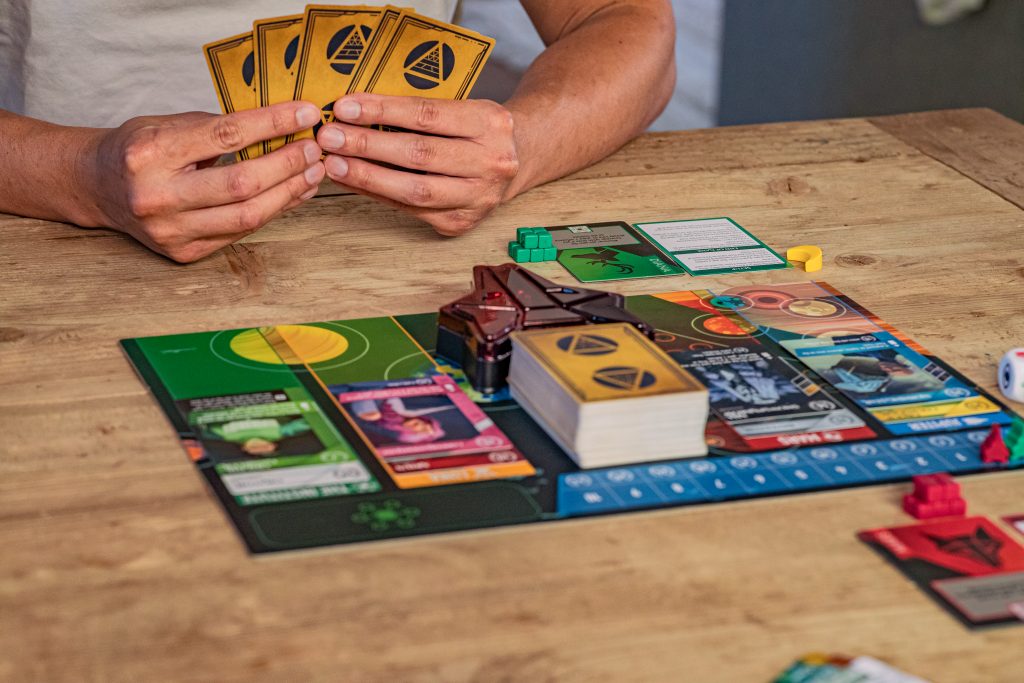
By the way, I just received professional photos from Tim Chuon of the standard version of the Red Rising–that’s what you see in this photo!
Today’s color of the day is Purple! Purple characters in the world are artists, media, and content creators. In addition to their conditional deploy abilities (artists can be quite picky), we wanted to give them so wacky-but-powerful end-game preferences. These are a few of my favorites:
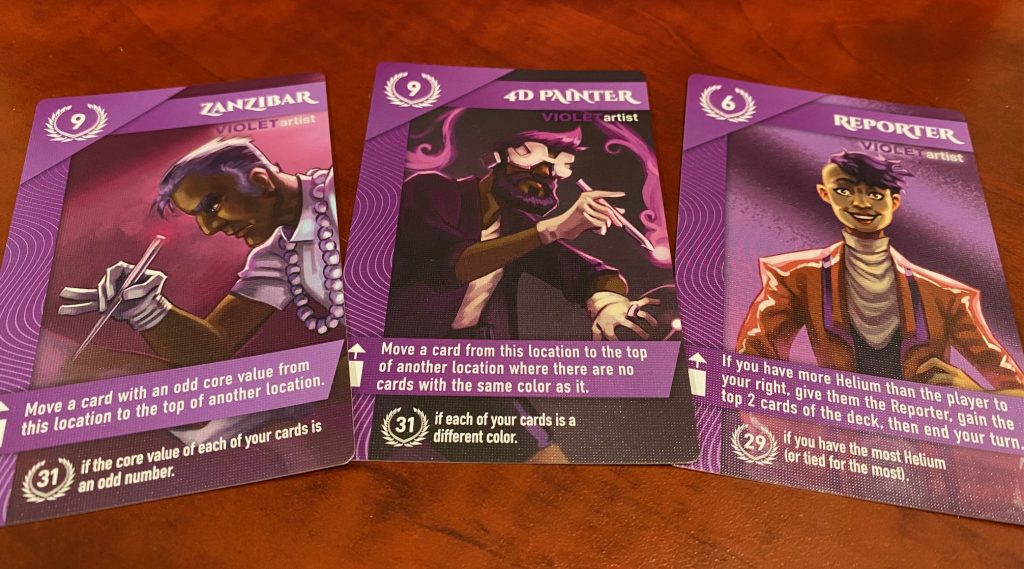
I really like the puzzle of trying to get all odd-numbered characters cards in hand or characters of different colors. While it’s definitely possible to do that, it’s hard to accomplish while also ensuring those cards combo together well, hence the high point values for these goals.
If you’d like to join me today for my Facebook livestream, I’m happy to answer all of your questions in real time on the Stonemaier Games Facebook page at 10:00 am CT.
February 9: End-Game Triggers and Abilities, Yellows, the Collector’s Edition vs. Standard Version
During the design process for Red Rising, Alex and I considered a few different options for end-game scoring, but it didn’t take long to find a favorite: When a player has at least 7 Helium tokens, a player has at least 7 Influence on the Institute, and a player has reached at least 7 on the Fleet Track (the same or different players), the game end is triggered.
We later added another option that really seemed to help in certain situations: The game can also end when any one player has completed 2 of those goals (e.g., if I have 7+ Helium tokens and I have 7+ Influence).
These two options combined to give players control over the pace of the game, to provide tension throughout the game, and to help the game scale well from 1-6 players. This is why Red Rising plays consistently in 45-60 minutes at any player count (though 2 or 3 players who know what they’re doing can play in closer to 30 minutes, especially given the minimal setup required).
Using the first-player token as a guide, after the game-end is triggered, play continues until each player has taken the same number of turns in the game.
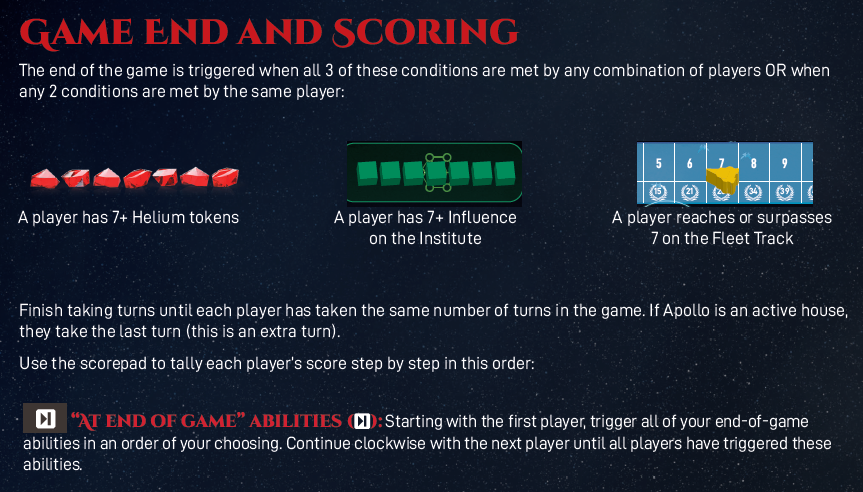
Before you proceed to end-game scoring, some characters have abilities to activate (starting with the first player). Today’s featured character type are Yellows–the doctors in the world of Red Rising–many of whom have these types of abilities.
For example, the Surgeon says, “[at end of game] Gain any 1 banished Gold.” So you might make sure during the game that you banish a Gold that you want to pick up at the end of the game. In fact, most Yellow characters with end-game abilities look at banished cards.
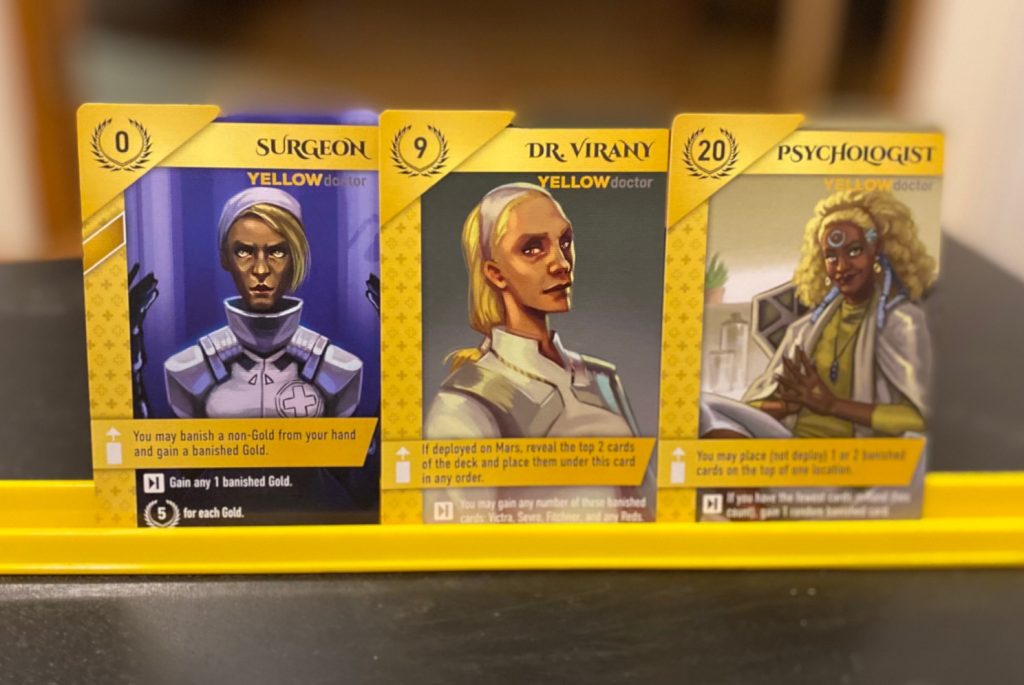
There’s only one last component that’s unique to the Collector’s Edition, so today I thought I’d share it and showcase the differences between the two versions. The component is the custom insert with a lid. The insert is designed to hold sleeved cards, and we’ve left room for more character cards to be added in the future in case we make an expansion.
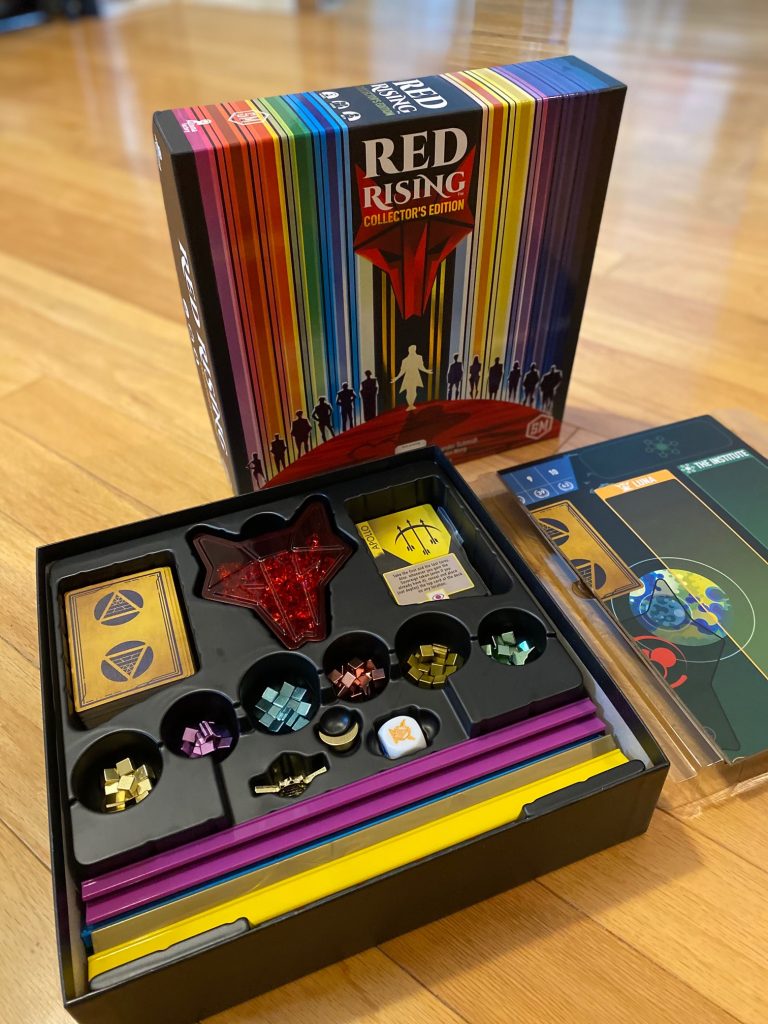
It’s been a long time since we made two versions of the same game, but we thought that offering a Collector’s Edition would be a good way to serve Red Rising fans (yet we also wanted to serve retailers by offering a more affordable version–the prices of the two games will be revealed when the preorder launches in March).
We defined the composition of the Collector’s Edition over time, adding the foil and individual numbering on the box, the foil on the Gold cards, the insert, the card holders, etc. One of the latest editions were the metal tokens. I love the heft of metal tokens, so at some point I asked my manufacturer, “Can we just make all of the tokens metal?” The answer was, of course, yes! So all influence tokens, fleet tokens, the first-player token, and the Sovereign token are iodized metal (zinc).
The Collector’s Edition will only be available directly from Stonemaier Games (shipped on an ongoing basis from fulfillment centers in the US, Canada, Australia, and UK (delivery duties prepaid to Europe). If we sell out and there’s enough interest for us to make more, we’ll make more. And for those who buy localized copies of the game (or buy the standard version from their preferred retailer, which we 100% support), you can also buy an update pack from us that contains the gold-foil cards, card holders, and metal tokens.
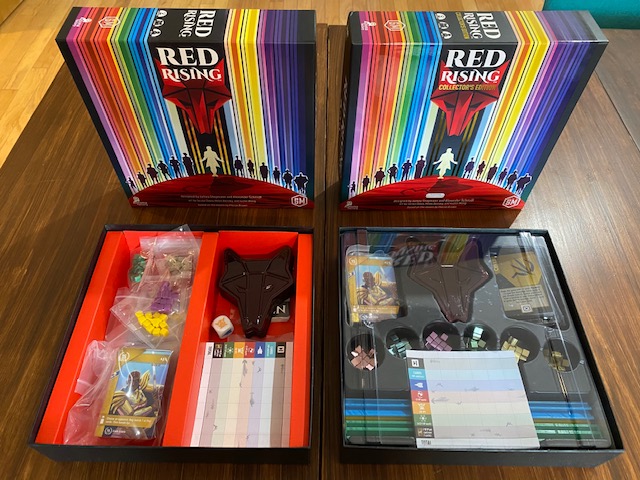
I’ll be back tomorrow for more reveals and design stories!
February 8: Obsidians, Banishing, Interaction, and Card Holders
One of my favorite groups in Red Rising are the Obsidians. I don’t want to spoil anything if you haven’t read the books, but the Obsidians are portrayed as the brutish assassins in the Society–they rival (and sometimes exceed) Golds in size and strength.
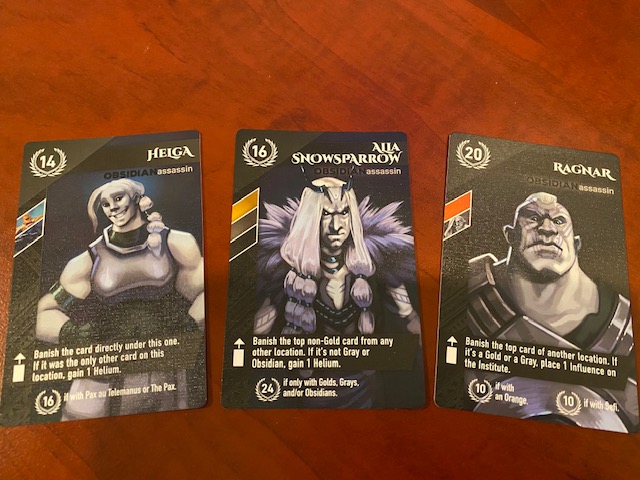
On these Obsidian examples (Helga, Alia, and Ragnar), you’ll see the word “banish”. Whenever you banish a card in Red Rising, you set it next to the board. It has essentially been removed from the game, though there are cards you’ll see later that care about which types of cards have been banished and can even revive banished cards.
This brings us to the topic of player interaction. The types of games we publish at Stonemaier are games where you have many reasons to pay attention to other players and some ways to impact them, benefit from their choices, or help each other. It’s very rare that we have any direct player interaction, and it’s never without consequences.
The world of Red Rising, however, is brutal. I’m drawn to Red Rising exactly because of the character interactions. As a result, we design some of the character deploy abilities to directly interact with your opponents, but always with the consequence that you’ve lost a card that may have been more valuable in your hand. Let’s look at Aja as an example:
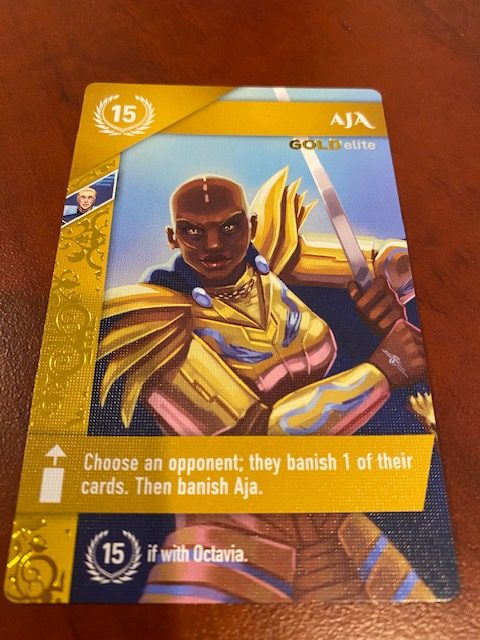
If you choose to deploy her, an opponent of your choice banishes a card from their hand. In most games, this is pure take-that, and I wouldn’t like it. However, in Red Rising, simply not deploying Aja could be a better play, because by not playing her, you get the points on the Aja card. So even with those 6 cards, you don’t have to feel like you’re missing out on interaction by playing nice, because playing nice is actually the better play in most cases—I’d rather keep Aja in my hand to get her 15 points and hopefully get 15 more points by finding Octavia and adding her to my hand. Instead, I can play another card from my hand and benefit more from their deploy ability.
Also, having one of your cards banished isn’t always bad, because sometimes you don’t want one of your cards (but you don’t want to deploy it, lest an opponent picks it up). That’s always part of the equation–for most cards you deploy, you’re giving opponents the opportunity to gain and play that same card against you.
We did try to strike a nice balance with the player interaction, though–there are fewer than 10 cards (out of 112) that directly interact with opponents, even though every choice you make in Red Rising impacts what cards your opponents can choose and where they can choose them from.
Before I close out for the day, I wanted to officially share one Collector’s Edition component you’ve seen in a few of the photos. We’re including custom card holders–one per House–in each Collector’s Edition. By placing your cards in the card holder, your hands are freed to fiddle with your metal influence tokens, examine cards from the board, and gesticulate when an opponent plays Aja against you.
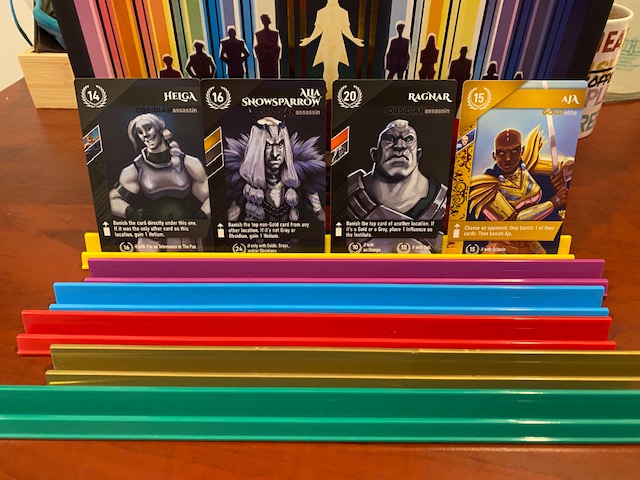
February 7: Co-Designing the Game, the Rising Die, and Greens
While I’ve co-designed a few expansions, it’s been a long time since I co-designed a full game. When Alex and I had the same epiphany for Red Rising while playing Fantasy Realms, I was excited to work with him on the game (especially after failing so many times while working on previous iterations of the game alone).
I can say from my perspective that it was a joy to work with Alex. Designing a game is a lot of work, and many co-designs end up relegating a lot of the grunt work (actually building one iteration of the prototype after another) to one of the designers. But that wasn’t the case with Alex. I think we both spent nearly the exact same amount of time on the game, which was awesome.
Before I get to the Rising Die and the Green character reveal, here’s Alex sharing his experience of co-designing the game with me:
 ***ALEX***
***ALEX***
Red Rising isn’t the first game design I’ve worked on, but it is a lot of firsts. It’s my first time working with another designer, my first time working on a game design directly under a publisher, my first time working with an IP, and my first time seeing one of my designs published.
Once I had finished reading (and loving) the books, Jamey and I worked together on the core of the design, brainstorming how we wanted the basics of gameplay to work. Then we split the segments of work. I created the majority of the unique cards and their powers. Then Jamey took that and put it together into a working game (he has a lot more experience with graphic design for prototypes than I do, so he also formatted the prototype). The experience was surprisingly easy. There was plenty of work to do, but having it split that way, it was much less overwhelming than most designs feel. We checked in frequently but both felt like we were only pulling our fair share of the work or less.
When we finally got to the first playtest, unlike most designs, everything just worked. Of course, there was plenty more work to do from there: fixing unique abilities that were too complicated or boring, balancing things, realizing the game was more fun if (almost) every card did something when you played it and had secondary endgame scoring conditions.
Jamey was both the more experienced (and acclaimed) designer/publisher in the blind-playtesting process. Jamey and I worked through each set of feedback separately and then conferred about what adjustments needed to be made and what didn’t. Not only was I listened to, but I was given the opportunity to learn a lot as part of this process. I learned quite a bit about development, fine tuning gameplay, and sifting between playtester opinion and actual potential gameplay concerns. Sometimes we implemented changes I wanted, sometimes we didn’t. Sometimes we simplified things I liked more complex, because it was better for the game as a whole. I believe the correct question isn’t whether I had an equal say, but whether I was respected and listened to. And I can say definitively that yes, I was, throughout the design and development process.
***
One mechanism that Alex helped out with quite a lot was related to drawing from the deck. After you deploy a card on your turn, you must pick up the top card from another location. But what if you don’t really want any of those cards? Or what if you’re simply more intrigued by what you could draw from the top of the deck?
So at first, that was it: If you wanted, you could draw the top card of the deck instead of from a location. But playtesters didn’t love it, as they were missing out on a location bonus.
When we tried adding a location bonus (I think maybe we tried associating the Sovereign token with it at one point? Or House abilities?), suddenly the drawing from the deck became a go-to option. As in, playtesters were preferring it to the cards on other locations. We’d gone too far.
Finally we found something that worked, something I wouldn’t have predicted: For a random card draw, we added a random reward, with certain aspects of that reward being distinctly weaker than others. Specifically, after you draw the top card of the deck, you roll the Rising die. It’s a large custom die with 4 sides featuring the same rewards as the locations (Helium, Fleet, Sovereign, Influence). One of the other sides simply has you revealing another card and placing it on a location, and the other side has you banish the top card of a location.
Adding this die as the reward worked beautifully. You’re still getting something, but you’re giving up control in the process. It means that drawing from the deck is fun, but not so fun that players will use that option out of proportion with selecting face-up character cards from locations.
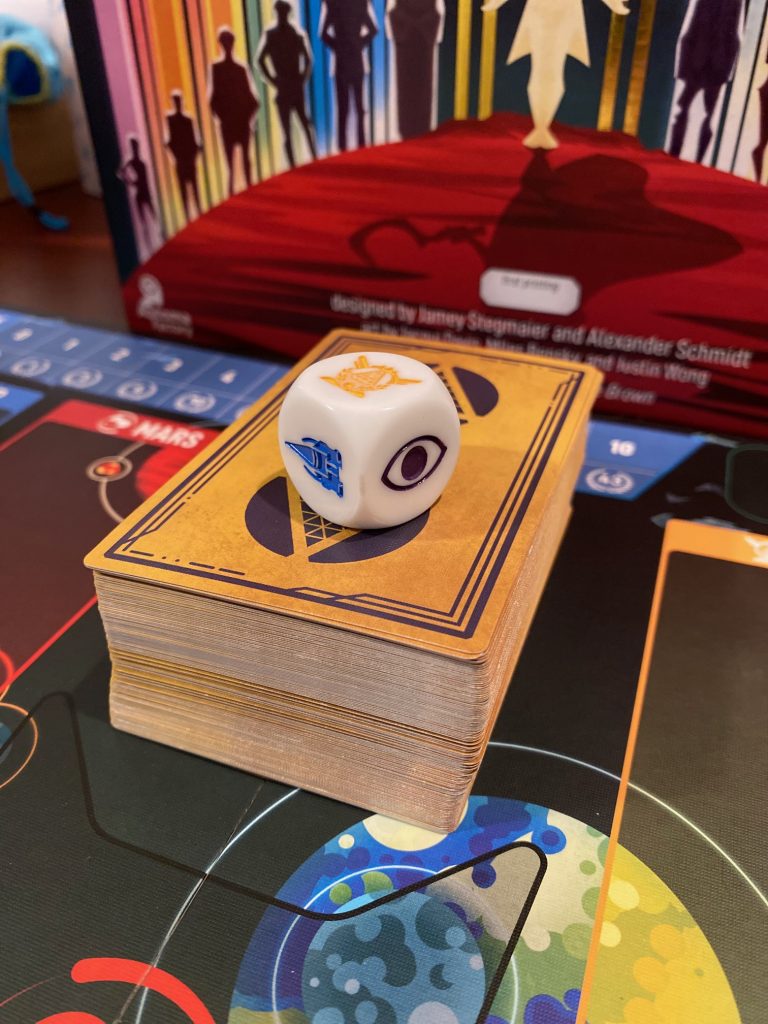
While we’re talking about the deck, now is a good time to feature Green characters! Many of the Green characters (like the Holo Designer and Firewall Expert) look at the top cards of the deck as their deploy abilities. A few of them even refer to the deck at the end of the game (before scoring), like the Online Gambler.
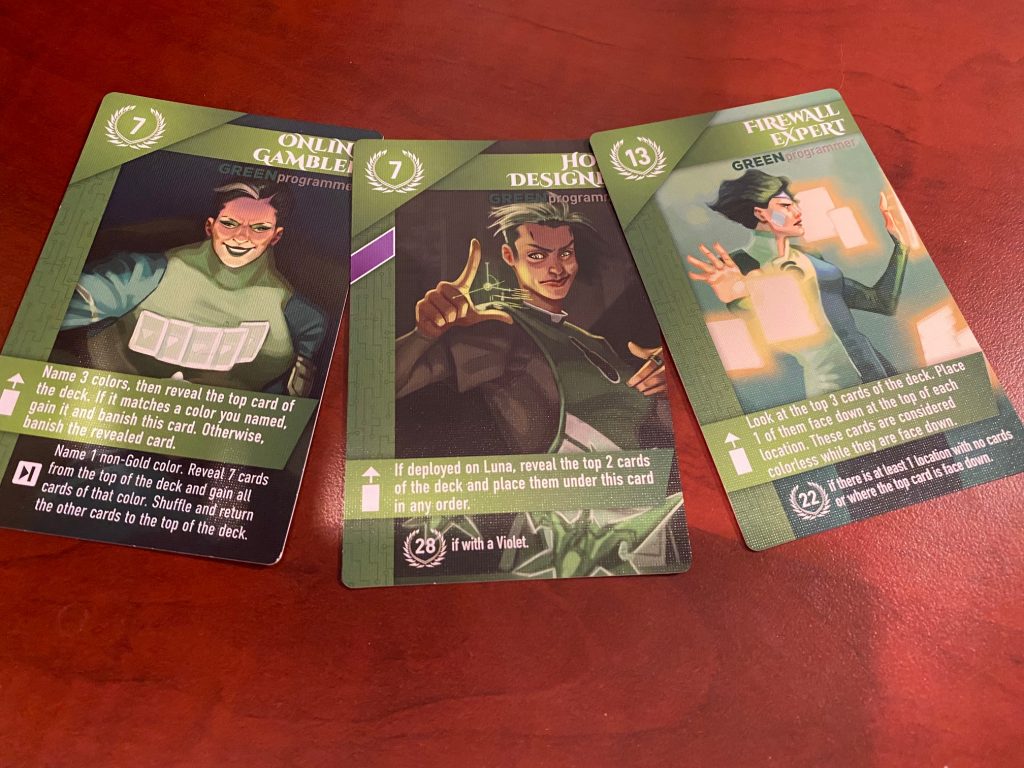
I’ll be back tomorrow for more reveals!
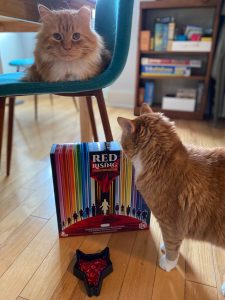 February 6: The Three Artists, Coppers, and Asymmetry
February 6: The Three Artists, Coppers, and Asymmetry
Back in 2017 when I had Pierce’s blessing to attempt to design a Red Rising game, I wanted to provide him with some art samples when I was ready to make my official pitch. My hope was to find a talented artist who already knew the Red Rising world.
When I found Justin Wong’s art on Pinterest, I knew that I had struck gold. Justin is an extremely talented artist and a big fan of Red Rising; I knew this because a significant portion of his art focused on Red Rising characters. Here’s his Instagram: https://www.instagram.com/justinwongart/
Justin had some openings in his schedule in early 2018, so he created quite a few concepts, characters, and the original box art (which, as noted yesterday, is now found on the back of the board). However, in 2020 when we were able to officially proceed with the game, Justin’s schedule was much busier.
This is where the other two artists came in. My friend Miles Bensky had fallen for the Red Rising world around the same time that he had taught himself how to illustrate, and much of the art he experimented with was of Red Rising characters. So I asked Miles if he’d like to join the project to focus on sketches of characters for which Justin hadn’t already created the concepts. Here’s his Instagram: https://www.instagram.com/mbenskydesigns/
As for the colors and rendering for these sketches, I thought Jacqui Davis’s style would be a good match for Justin’s. Jacqui was the artist for Euphoria and the Euphoria expansion, and she is really great to work with. So Jacqui joined the project to bring life to all of the character sketches (and make the board and box art). Here’s her Instagram: https://www.instagram.com/logicfairy/
Even with three different artists, the end result–in my opinion–is seamless across all 112 character cards. That was the goal.
To showcase some examples, the color of the day is Copper! Coppers are the bureaucrats of the Society, and they often impact your influence tokens or look at your influence tokens at the end of the game. And yes, as teased yesterday, the influence tokens are metal in the Collector’s Edition (vs plastic cubes in the standard version). Each player has 10 of them.
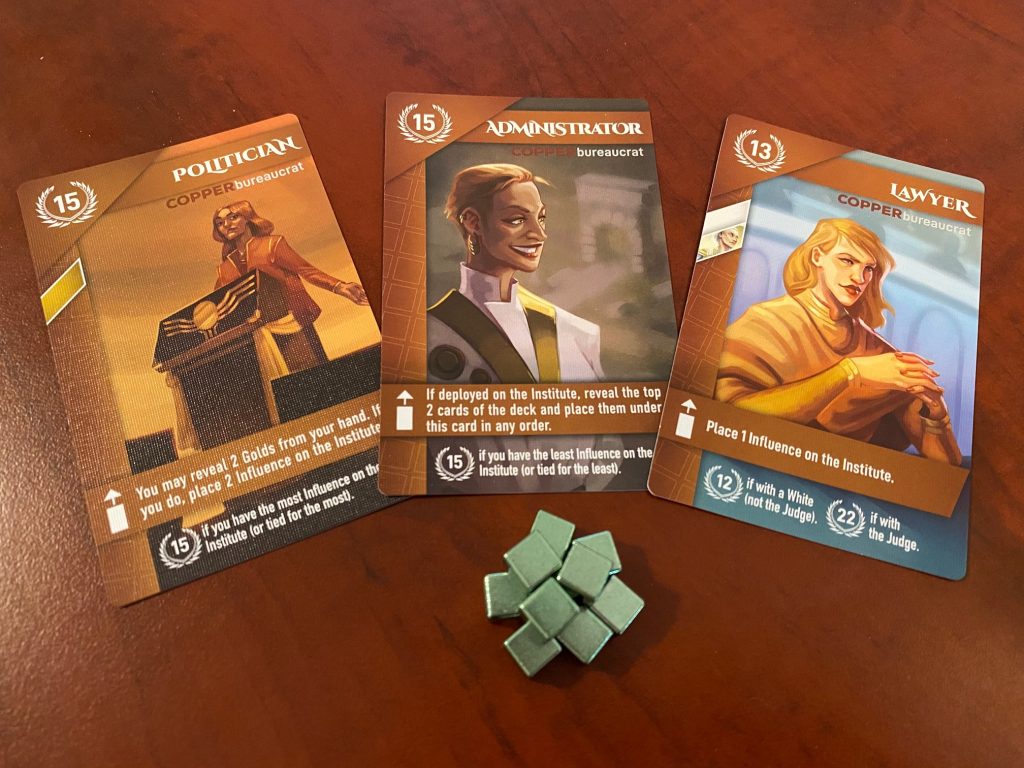
Also, while we’re talking about art, one set of non-character illustrations that Miles created are the House symbols you’ve probably seen by taking the personality quiz on our website. There are 6 Houses featured in the game, and each player will randomly gain a House tile at the beginning of the game (or you can use the House that recruited you via the personality quiz the first time you play).
Alex and I experimented with a lot of different options to provide some element of asymmetry to the game, as the world of Red Rising is full of different families, planets, and businesses that offer inherent strengths, weaknesses, and objectives. We eventually decided on the Houses from the Institute to separate the assigned asymmetry from the family-specific Gold cards you may end up with during the game.
It also took us a while to figure out exactly what type of asymmetry the Houses added. For example, we tried making the Houses secret (like in Lords of Waterdeep), and you’d reveal them at the end of the game to gain extra points based on a certain goal. We also tried giving Houses ongoing abilities (which players often forgot), and then we tried simply giving each House a one-time starting benefit. That functioned fine, but it didn’t really feel like you were playing a certain House.
We ended up with something strikingly similar to my favorite game of 2020, Dune Imperium, even though I didn’t play it until long after Red Rising had gone to print. Each House tile has an ability that triggers whenever you gain the Sovereign token (which happens when you gain a character card from Luna). This made gaining the Sovereign token much more satisfying, and it was an easy way to remember House abilities.
A few of the Houses also retained special starting benefits, like House Apollo shown here. Usually the first player token–a crescent moon, which is, of course, metal in the the Collector’s Edition and plastic in the standard version–is randomly assigned to a player. But if you’re House Apollo, you take the first and last turn of the game, so you automatically get the first-player token.
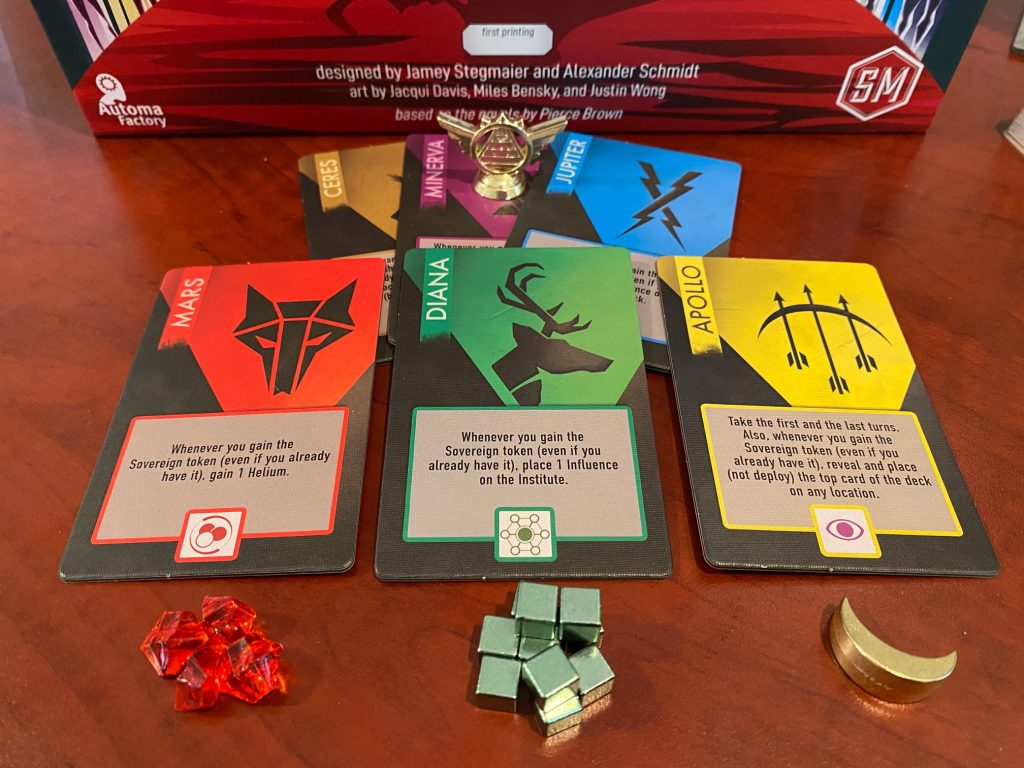
Which House will you play in your first game of Red Rising in a month or so?
February 5: Intellectual Property, Working with the Author, the Board, and Reds
After getting hooked on the first book in 2014 and the second book, Golden Son, in 2015, I reached out to Pierce’s literary agent, Hannah, about the tabletop rights for Red Rising. At the time, the rights weren’t available (most likely they were wrapped up in a deal focused on other media).
In 2017 I decided to try again, and this time the tabletop rights were available. I had a call with Hannah and Pierce to learn more about their hopes/preferences for a Red Rising board game, which mainly involved making something awesome and accessible for fans while still providing a great experience for hobby gamers who might be introduced to Red Rising through the game.
I’ll flash forward a bit past my initial failures to design a game with which I was satisfied, then finding the rights may no longer be available, to the wonderful day when we got the tabletop rights, navigated through the legal portion, and officially signed the paperwork. At that point we had fully designed the game and were well into the art process, as the art for this game took a long time (more on that in a future post).
 Throughout this time and in the days that followed, I tried to respect Pierce’s time as much as possible. It was my job to design (ultimately, co-design) and publish a game; it’s Pierce’s job to write books. So other than that initial call in 2017 about what they game could be, after we got the rights, I recall only reaching out to Pierce to see if our launch date worked for anything related to his book schedule (no conflicts there–he’s currently writing book 6), to share a fancy prototype in September to make sure we hadn’t botched anything big, and (earlier in the year) to get his thoughts and approval on the box art.
Throughout this time and in the days that followed, I tried to respect Pierce’s time as much as possible. It was my job to design (ultimately, co-design) and publish a game; it’s Pierce’s job to write books. So other than that initial call in 2017 about what they game could be, after we got the rights, I recall only reaching out to Pierce to see if our launch date worked for anything related to his book schedule (no conflicts there–he’s currently writing book 6), to share a fancy prototype in September to make sure we hadn’t botched anything big, and (earlier in the year) to get his thoughts and approval on the box art.
Originally, the box was going to showcase the sweeping space opera of Red Rising, and artist Justin Wong made an awesome illustration for this. That was in 2018. However, in 2020 when I talked to Pierce, I mentioned the possibility of going with something simpler and more iconic, kind of like a Mondo movie poster. Pierce indicated a preference for that, hence how we ended up with the final cover.
However, we didn’t want to waste the original box art, so we reconfigured it for the back of the board. You get two box illustrations for the price of one! :)
As for the front of the board, I mentioned yesterday that you get a location-specific bonus when you gain a card at the end of your turn (on “Lead” turns). So let’s briefly discuss what those location bonuses are, featuring some Red characters (I’m going to showcase a different color every day).
If you gain the top card of Jupiter, you advance once on the fleet track, which has escalating victory points.
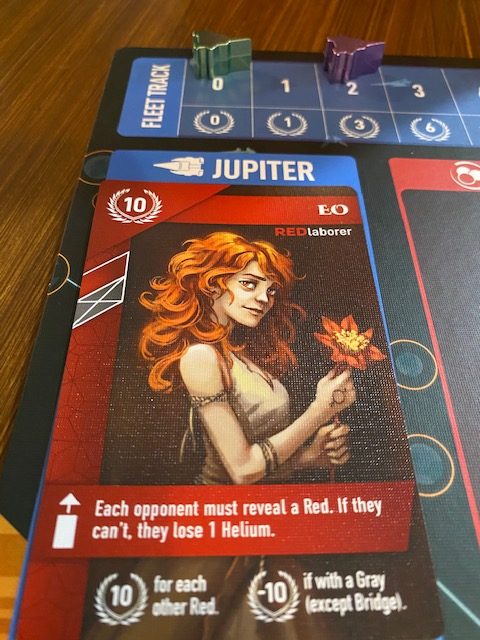
If you gain the top card of Mars, you gain a helium token, which is worth 3 VP at the end of the game. This value is a nod to helium-3 in Red Rising, which is a mineral that fuels ships (not a gas like normal helium).
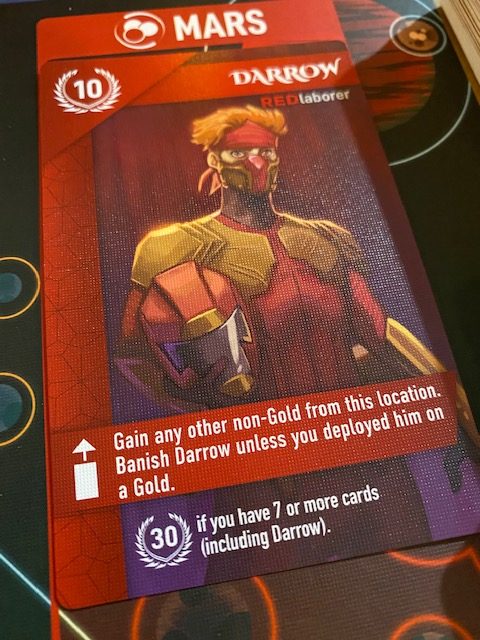
The helium tokens themselves are stored in a wolfs-head tray, which is included in both versions of the game. It’s kept on the board during the game and seals tight with a custom lid in the box.
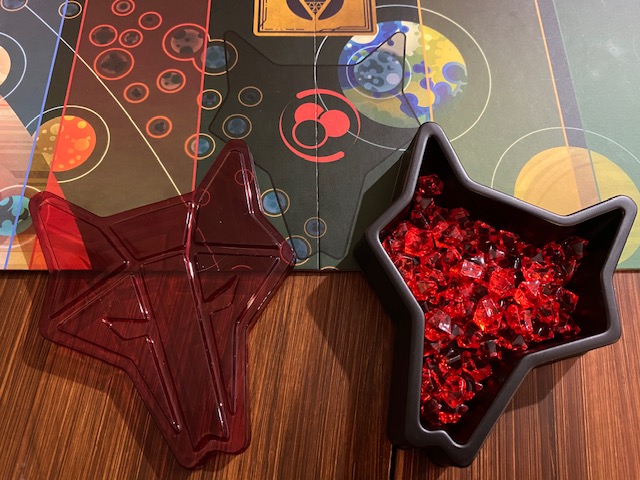
If you gain the top card of Luna, you gain the Sovereign token, which–in addition to triggering special bonus I’ll discuss in an upcoming post about asymmetry–gives you 10 VP at the end of the game. There’s only 1 Sovereign! The Sovereign token is gold-painted metal in the Collector’s Edition (plastic in the standard version).
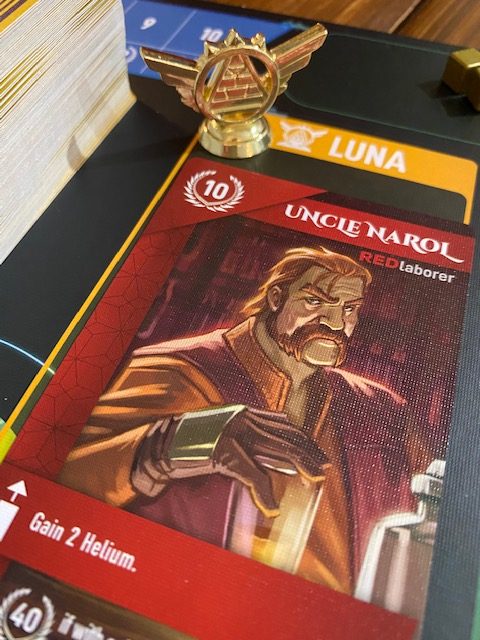
If you gain the top card of The Institute, you place 1 influence token nearby. At the end of the game, the player(s) with the most influence tokens gain 4 VP per token, then 2 VP per token for second place and 1 VP per token for all other tokens. In a 2-player game, you’ll place 3 tokens for a neutral third player here to compete against.
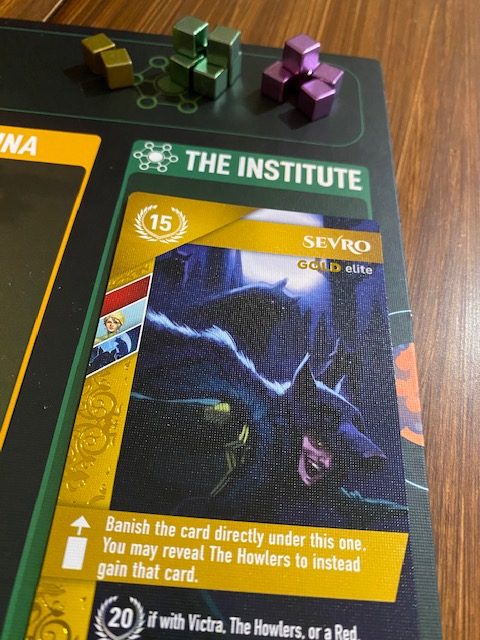
You can also gain the top card of the location deck, but there’s a design story behind that–I’ll discuss it later.
This covers all of the ways you can get points in Red Rising. Many of them come from the points printed on the cards (upper left and bottom), but quite a few come from the fleet track, helium, Sovereign, and influence.
I’ll be back tomorrow with a new color and more reveals!
February 4: Failed Attempts, Fantasy Realms, the Core Mechanism, and Gold Foil
I’ll soon delve into the story of getting the tabletop rights to Red Rising. But today, here’s the context you need to know: I love the Red Rising books, and for many months of 2017 and 2018, I had author Pierce Brown’s blessing to design a game in that world.
Yet I failed, time after time. You can see me recount this in detail in a YouTube video posted in the spring of 2018. There are 14 different color castes in the dystopian society of Red Rising (with reds at the bottom, hence the name), and I kept trying to represent those colors as meeples in worker-placement and bag-building games. It was simply too many types of workers, and they were too detached from the theme.
On the video, I mentioned that other designers were welcome to give it a try too and submit their games to Stonemaier. I think we played 3 or 4 really solid submissions, most of which zoomed out for big space opera. That’s great, and the scope of Red Rising is huge, but at its heart are the characters, their relationships, and the tough choices they make. I just wasn’t getting that in any game, whether it was my design or someone else’s.
Alex is in my gaming group, and I talked to him about this from time to time. Here’s Alex describing the breakthrough moment:
“Our breakthrough came while we playing a game of Fantasy Realms with friends during one of Jamey’s game nights. Fantasy Realms is a filler hand building gamer, and the designer, Bruce Glassco, manages to have 10 suits in a 53 card deck. If he could do that, why couldn’t Jamey and I use a similar concept of hand management/building, give a little bit more meat to its gameplay, and do it with 14 suits?”
After a few brainstorming sessions, we put together a prototype, and it actually worked!
In Fantasy Realms–an excellent filler game that I highly recommend–each player is dealt a hand of 7 cards from a deck of 53. Some of those cards may combo together; others will not. On your turn, you draw a card (from the deck or face-up cards), then discard a card. At the end of the game, you add up the points for all cards in your hand to determine your final score. There are no benefits or interactions during the game–everything builds towards your final hand.
In Red Rising–which, at 45-60 minutes, is not a filler–each player is dealt a hand of 5 character cards from a deck of 112 unique cards. In this deck are 7 cards of each color, as well as 21 Gold cards (Golds are the elite class in The Society). On your turn, you will usually deploy a card from hand onto one of the four locations on the board. Most characters have “deploy” abilities that trigger when you do this. So it’s a matter of which characters benefit you more through deployment than keeping them in hand for end-game scoring.
Then you gain a card from either one of the other locations (i.e., you can’t just pick up the card you deployed) or the top of the deck. When you do, instead of just gaining a card, you also gain the benefit of that location–I’ll delve into the board benefits in an upcoming post.
I love double benefits like this in games. In fact, it’s almost a triple benefit: On almost every turn in Red Rising, you’re gaining a benefit from deploying, a new card, and a benefit from that card’s location.
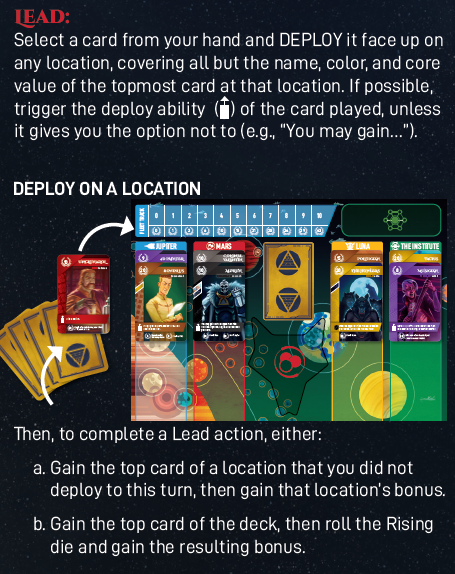
Also, if you’re 100% happy with your hand, instead of being forced to deploy a card, you can simply take a “scout” turn in which you reveal a card from the deck and place it on a location of your choice. You then gain that location’s benefit. This actually happened in a game I played with Megan last night–she was really happy with the combos in her hand, so she spent several turns scouting. She won!
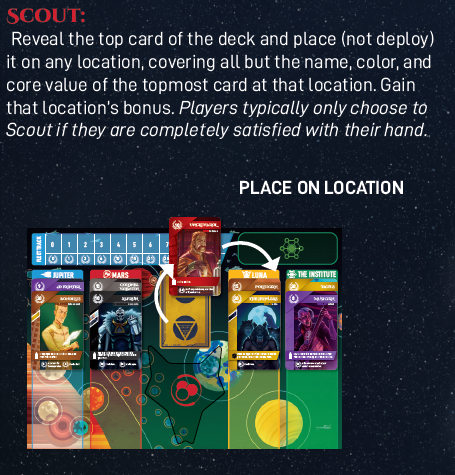
It may sound simple, and that’s by design: Red Rising is incredibly easy to learn, but every character card truly is unique, so you’re faced with tough choices throughout the game. Characters in Red Rising are constantly faced with decisions about who to trust and who to scorn, and we wanted the game mechanisms to reflect those decisions.
Before I close out for the day, I want to show you one of my favorite components in the Collector’s Edition game. As I’ve mentioned, the gameplay elements between the two versions are identical. There are 21 Gold character cards in both versions. However, the Collector’s Edition Gold cards have gold foil on the sidebar:
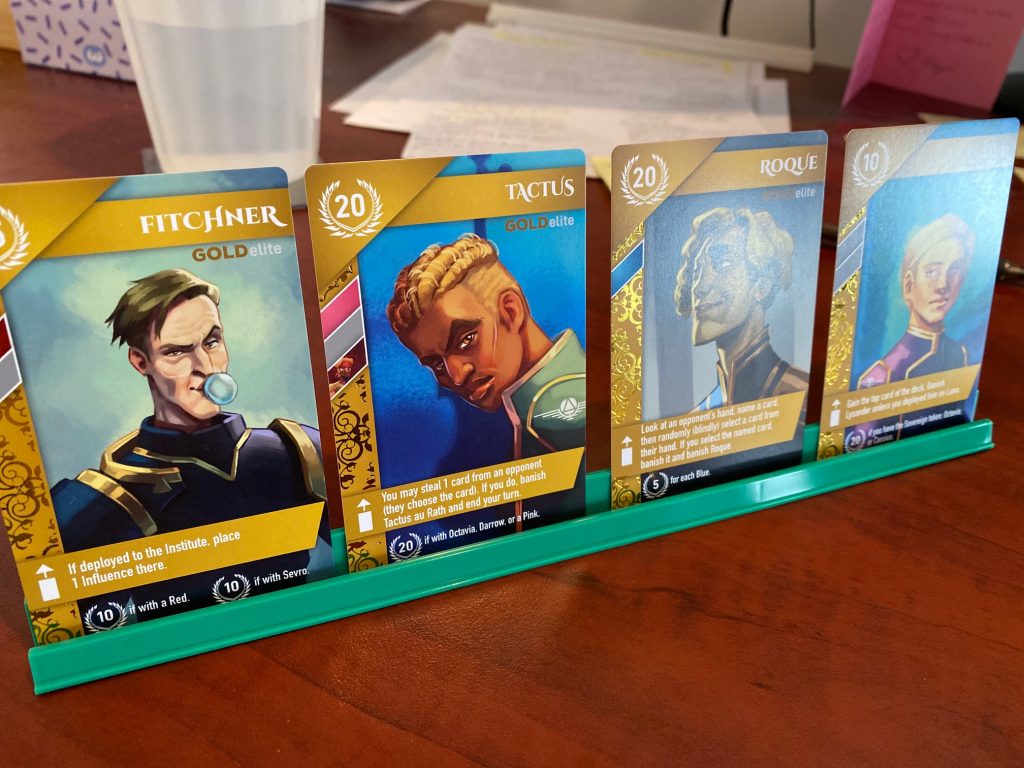
I’ll be back tomorrow with a new post. What do you want to know next?
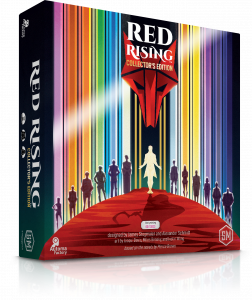 February 3: Let’s Begin!
February 3: Let’s Begin!
I’m always incredibly excited when I get to finally announce a new game, and Red Rising is extra special to me because of how much I love the book series and how long I’ve tried to bring it to life. I’ll soon delve into details about the components and gameplay, but today I just wanted to briefly mention a few aspects of this project that are already known
Launch Notification Signups = ACLU Donations: Given the dystopian themes presented in the Red Rising books, we’re donating $1 for every launch notification request entered here by February 16 to the ACLU to support and protect the rights of those who are underrepresented and marginalized. This isn’t an enewsletter–it’s a one-time notification that you’ll receive in March when the preorder goes live.
Personality Quiz for Houses: In the game, you play as one of six houses that reflect the houses found in the first Red Rising book. One of our supporters, Ryan Davis, created a 3-question personality quiz to determine which house you are most likely to be recruited into. Feel free to take the quiz here and share the results on Instagram or the Red Rising Facebook group!
Read the Books Now or Later: In today’s Facebook livecast, many people asked if they should read the books now or wait until after they play the game. The game features many of the characters featured in the first Red Rising trilogy (there are also two books available in a second trilogy), but the game isn’t focused on the story or plot. Basically, we wanted to design a game that would be as immersive for Red Rising fans as it is welcoming and spoiler-free for those who might discover the world of Red Rising through the game. So yes, if you’re looking for a good book, go read Red Rising! But you can play the game with no knowledge of the books, and the game won’t spoil the books.
Two Versions: Stonemaier Games will be selling a Collector’s Edition of the game through our March preorder, and retailers will be selling a standard version a few months later. The two versions are identical in terms of gameplay; the only differences are certain components that I’ll discuss soon. If you want to support your preferred retailer, you’ll be able to later order an upgrade pack from us. But we’re also happy to sell the Collector’s Edition directly to you through the March preorder, shipped from fulfillment centers in the US, Canada, Australia, and the UK (duties prepaid if you’re in the EU).
That’s it for today! I’ll be back tomorrow with some juicy details.
Most design diaries will be written, but for this first day, here’s a video of my Facebook livecast in which I answered a number of questions about Red Rising:
70 Comments on “Design Diary”
Leave a CommentCancel reply
If you ask a question about a specific card or ability, please type the exact text in your comment to help facilitate a speedy and precise answer.
Your comment may take a few minutes to publish. Antagonistic, rude, or degrading comments will be removed. Thank you.
Jamey, it’s a blast to follow your videos and play your board games. I just ordered the collector edition (my first deluxe game) and the book trilogy. Keep up the good work!!!
Thank you!
Hi Jamey, thank you for your fantastic games. I was wondering, what is your thought about translating your diaries for foreign-based blogs? Thank you!
Thanks Barbara! Is Google Translate not doing it well? It’s a lot of content to translate. :)
As a professional linguist you can imagine what my reply would be :D Naturally, I’d cut it a bit shorter, about 1,200 words :)
This is the first time I’ve pre-ordered a Stonemaier game. Never heard of the books before, but the game looks really fun. Between this and Stardew Valley it is shaping up to be a great year for new games. Also really looking forward to a Viticulture expansion.
Thanks for joining us for the first time, Ryan!
For cards with deploy abilities like that of Calliope (Reveal the top card of the deck, then deploy it face-up on another location), are your choices how does that affect your options when picking up a card to your hand that turn? You are not allowed to pick up the card you deployed, which would normally leave you with the other three locations as options. With the Calliope deploy ability, you are deploying two cards to two different locations on a given turn, so are you restricted to only picking up from the remaining two locations (and the deck)?
Most characters that move cards in that way don’t deploy those cards–Calliope is special in that way. :) For her, you’re trying to (a) maximize the ability of the other card you deploy and (b) pick a card/location that you don’t think opponents want. You’re correct that you cannot gain a card you deployed this turn, so you’re limited to the other two locations and the deck.
Hello!
I’m just curious if you can speak to how you determined the proper balance for the house abilities. Was there a certain amount of points you were aiming for each house ability to be able to acquire throughout the game? I’m just noticing that all things equal (sticking with 7’s) with say mars has 7 helium, Diana places 7 influence, and Jupiter get’s to 7 on the fleet track they end up with 21, 7/14/28, and 28 points respectively, seeming to leave mars falling behind, and then how many potential points could an extra turn for Apollo reap? And Minerva being very luck based, what if they continue to roll the X, getting no or few bonus points? And Ceres seems like it would take some real skill to navigate compared to the others, trying to get cards that benefit from the banish mechanic, and trying to make decisions on which cards are best to banish to screw others up while trying to play it so you can possibly uncover a card you want and hoping it’s still there when it comes back to your turn?
Just to be clear, I’m not saying they are unbalanced. I haven’t played the game yet so can’t say either way. I’m just curious about your thoughts on the balance, and what your decisions were that lead to the balance you struck!
Thanks!
Ryan: Playtesting and data analysis! :) While your house may lead you in a certain directly, it’s up to you to craft a hand and make deploy decisions throughout the game that result in a high point total. Overall, the stronger core abilities (Ceres and Apollo) are paired with the weaker sovereign benefits (i.e., banish and reveal).
Weird question, you’ve mentioned that there will be an upgrade pack for the standard edition for getting the upgraded metal components but will there be anyway for people who own the collector’s edition to get the regular plastic tokens outside of buying a copy of the standard edition? I love metal components, the weightiness makes them feel amazing, but I find it hard to tell between the house Ceres and Apollo colours.
Thanks for your question. No, we don’t plan on selling plastic cubes, but there are plenty of stores where you can buy plastic and wooden cubes. :)
I like that Megan, Biddy and Walter are named in the rulebook as a scoring example. It’s a nice touch. Looking forward to playing it.
This is my first time preordering for a board game, especially online. Should I consider being online a couple minutes early on March 3? Just in case the game would sell out?
I am very excited to add this to my collection. Scythe and Wingspan (including the expansions) are the games that got me and my family into the hobby. Cannot wait to add this, especially the collectors edition, to my collection. Thanks and Much Love!
Thanks Gene! We’ve never had a game sell out in the first day, so I think anytime on March 3 (particularly in the morning) should be fine. The order in which preorders are placed won’t have any connection to the order in which they’re shipped (Champion orders will ship first, then other orders).
I appreciate you Jamey.
I am a registered nurse and a lot of the nurses on my unit will be placing orders in that morning! Thanks again!
Thank you so much for your service!
It’s my pleasure, thank you!
just saw the Gray Ugly Dan card and am now assuming him to be the most overpowered card in the game as he can be treated as any other color in addition to gray and has a core vale of 20 and gets “five extra points for every red and brown on a location” Which could give him a maximum bonus of 70 extra points potentially making Ugly Dan (one of the most pathetic charicters in red rising) the strongest card in the game!!!!!!!!
(((if i have missunderstood how this card works please correct me)))
Potentially, but with 14 colours in the game it’s likely there won’t be anymore than 2 Red/Brown on the field if that.
Jamey,
Was there consideration to use a reusable score card (dry-erase) rather than the paper sheets during the design process? Would that have blown the price out of Stonemaier’s desired price range for games? If there was enough interest in an accessory like this would you consider producing one?
Excited for Pre-Order!
Mitch: Thanks for asking about this. We generally prefer scorepads, as they give players an artifact they can use to look back at previous games. For that reason, we didn’t consider a dry-erase option for Red Rising.
Jamey: I appreciate the quick response. I always worry about running out of sheets down the road and not being able to find replacements. Granted, it looks like one would have to play over a hundred games based on the sheet stack I see in the photos.
Thank you for all you do for the board gaming community. Love your Wednesday chats (which I try to always catch LIVE). Along with the plethora of information you provide for aspiring game designers and Publishers.
Cheers to another beautiful game!
Edit: I was assuming the number of sheets. Could be less and dont want to put miss information out there. My apologies. Jamey do you know the sheet count for the score cards?
Yes, it’s noted in the design diary post about the scorepad and on the components list on the main page: “We include a 50-page, double-sided score pad in the game. It’s good for 100 six-player games (or 200 three-player games, or 300 two-player games).”
Just curious, why does the end of game scoring for Modjob include 5 points for himself, if I’m understanding that correctly. Why not just have the card value at 15? I’m sure there’s a reason, as I’m writing this the only thing that possible comes to mind is the end of game on other cards that give bonus for odd/even core value cards. Again, just curious. Thanks – can’t wait to get my hands on the collector’s edition!!! (And because of you, I’m reading the books, finished the 1st & onto Golden Son now. They’re great – getting me so hyped for the game!)
It’s to prevent confusion as to whether or not Modjob scores himself. If we didn’t put that there, players would wonder if Modjob does or doesn’t count. :)
That makes sense – thanks for answering.
I’ll admit I was getting concerned in how to count up points across all cards and locations, but looking through the cards posted so far I’ve started to notice they have nice pentamerous scores when connected to their bonuses. I know it was mentioned but it’s cool to see the implementation. Nice touch!
I signed up as a Champion, does that mean I’ll get the game sooner? I’m incredibly excited about this one!!
If you place a preorder for the game in early March, your order will be shipped before non-Champion orders in your region. Thanks for becoming a Champion!
Awesome! Oh don’t worry, I’ll be pre-ordering day one :) Thanks!
Do Justice and Martyr have different texts for the same block effect, or am I reading that wrong?
Slightly different, yes, but same meaning.
I was just wondering the same thing.
Was so happy to see a Board game being developed for one of my favourite novels! Was even happier when I discovered it was being made by one of my favourite game designers!! And not having to wait 12-18 months for a Kickstarter was the cherry on top :)
Too late into production, i know, but the Gold foil looks so great on the gold cards I think it would have been awesome to see foil for the other metal colours too (silver, copper). Either way, a very nice and polished looking product. Very happy with how the art turned out for each of the characters too!
Thanks! We considered that, but I thought that it would work best thematically if only the Golds had foil, especially since the Golds are kind of the featured card in the game (there are 7 of each color except Gold, which has 21 character cards).
Hi Jamey, first of all I’m really exited about this game, I even bought the first book :) But I have a question about a possible Dutch version. I have asked 999 games about this and they said that Red Rising is unknown to them. So that would mean there is not gonna be a Dutch version. For me it’s not a real problem, because then I would pre order the Collecters edition from Stonemaier itself. So my question is, is it 100% certain that there won’t be a Dutch version? Because that will determines my disicion for what edition I will get.
Thanks in advance
Marten: Thanks for trying the book! 999 Games does know about Red Rising, though maybe the person you talked to doesn’t have current information. My hope would be that they do make a Dutch version, and I’m a little surprised they didn’t join the first print run. But there is no Dutch version in the works as far as I can tell.
That clears things up. Thanks for your answer Jamey!
Any insight through testing how the gold foil holds up through wear and tear of play.
Our manufacturer, Panda, has an excellent track record with all of their components, including foil products. So I trust that they’re going to hold up for a long time. And if they don’t, we’re always here to help out with replacement parts.
Hi Jamey,
I think I saw a comment about ordering the upgraded components separately.
As someone wanting to support my FLGS but also liking the collector’s edition components highlighted so far, would my best option be to order the retail version through my FLGS, and then order the upgraded components separately?
If I did that, would the retail box have space for those extras? i.e. the card holders
Erik: Exactly! Yes, that’s how you’d do it. The box sizes are the same, so the components fit in either box.
Great, thanks so much!
Would those upgrades also be available for the pre-order in March, or later than that?
Probably a little later, as I don’t want to confuse people during the preorder for the game itself.
Hey Jamie,
Would it be a spoiler if we knew what size the cards were, and if the insert could handle sleeves?
Thanks regardless. Look forward to the rest of the dev diary—and the preorder!
Not at all–in fact, the card size is on the main Red Rising page of our website! :) See the first bullet point. 65x100mm are the same size as 7 Wonders cards. And yes, we make cards, inserts, and boxes that are friendly for sleevers and non-sleevers alike.
In my excitement I totally missed that—thanks for your kindness!
Jamey, first of all I’d like to say that I really enjoy your games and games your company publishes. Scythe is a top five game for me. I really enjoy Tapestry, Viticulture, and Wingspan, too. The Red Rising saga is my all-time favourite book series. So, when I found out last year that you had tried to create a game set in this wonderful and dynamic universe I thought it was a cool idea and was slightly disappointed this perfect marriage wouldn’t happen.
Upon discovering Wednesday night that this game actually was happening and that it was basically upon us…I was ecstatic. I don’t have the words to describe my elation and excitement. I have since watched the Youtube video where you described you initial attempts that came up short to design this game. And I feel very confident that this game is in good hands with someone who loves the property, the world, and (most importantly) the characters as much as I do.
My question is more along the lines of how the feel of the game is. The books are epic and grand in scope. And I was just wondering if (and moreso how) you capture that feeling in the game and how it’s experienced when playing. I guess this would require more anecdotal evidence; which I don’t know if you can share without conveying spoilers or maybe you even have a future entry planned to discuss this. Any information you can share would be appreciated.
Again, keep doing what you’re doing. Your work and that of the team you’re surrounded by is phenomenal! Thank you for your endurance in making this passion project a realization!
Thanks for your comment, Laurence, and it sounds like we have similar taste in games and books! :)
You’re right that the scope of the Red Rising books is huge. In my original attempts to design the game (and in some of the games that were pitched to us), I tried to encapsulate that entire scope. The result wasn’t great. Players felt far too distant from the action, the characters. It felt like flying over a concert instead of being in the crowd.
So what I found worked is to focus on the characters, because they’re what brings Red Rising to life for me. Their personalities, their relationships, their sacrifices, and tough choices they make every day. There are 112 unique characters in the game, and you’ll be faced with the tough choice every turn as to which character will leave your house (and where they’ll go), followed by which character will join you. In this way, I feel like we were able to capture the essence of the books, but I welcome you to be the judge of that in March! :)
That honestly makes a lot of sense. The only game I can think of that has an epic and grand feel like Red Rising is Twilight Imperium. A game of that scope would be nearly impossible to connect with the individual characters at the same time. And the characters are the lifeblood of Red Rising.
Also, 112 unique cards is IMMENSE. Everdell, another top five game for me, has (if I recall correctly) 128 cards in its base game. And none of them are unique, as they occur mostly in pairs and threes. So, I can get a sense of the grandness of scope there already while still keeping us connected to our beloved characters and immersed in this vibrant world.
I am looking forward very much to experiencing it for myself. I signed up as a Champion Wednesday night and subscribed to be notified of the game’s launch. My friends are also following along with this one closely. We are ready to break the chains and live for more!
Red Rising could absolutely handle a game like Twilight Imperium. If someone made a game like that I would be excited to play it! It’s very easy to read the books and imagine playing that game.
To me there were two major reasons that this is not that game:
1. As Jamey mentioned, we wanted a game that really focused in on the many amazing, unique characters that also allowed all of the castes/colors to share focus. A game like that wouldn’t do this.
2. We wanted to make a game that’s friendly to people who love the novels but are new to gaming. A game like Twilight Imperium is not that game. We could have made a simpler game in that vein (and Jamey tried) but it starts to lose something as you take elements out.
I’m really happy with the route we took and hope you end up agreeing!
Trying to stay spoiler free, but I’m curious if we will see another Darrow card in the game? Also the Collectors Edition totally includes a Sling Blade, right?
Each character only appears on one card in the game. A sling blade would be awesome…but just a bit too big to fit in the box.
Jamey,
As an unpublished designer I’m often inspired by various television series and movies. Most designers advise to design games free from the restraints of Intellectual property so you are not tied down to one possibility where the license may not be available or may be far too expensive. I’d love to get an author’s input and blessing for a game design but wonder if that could cause problems down the line if you don’t work out a deal but want to go ahead with your game without the IP. Could you share some of your experience with this and advise for how far to design your game specifically for that IP before you reach out to the author?
John: Thanks for your questions. I’ll delve into this in a blog post next week, but my overall recommendation would be to proceed to design the game, prepare a short pitch for the author and their agent, and then present it to them if you have the opportunity. If they decline, you can change the game so it pays homage to the book but isn’t confused with it.
Thanks Jamey. So if they turn you down, how do you know how much to change and how much you can still keep without causing a copyright issue? Are you ok as long as you don’t use their specific name or reference to it?
Just don’t violate their copyright, and it won’t be a copyright issue. :) That is, don’t use the name of the book or specific characters/locations in the book. You can even make it clear in the rulebook by saying that you were inspired by the world of X, but that this game is its own thing.
Also, though, I’m not a lawyer. Here’s an article from a lawyer about copyright: https://stonemaiergames.com/kickstarter-lesson-159-everything-a-kickstarter-creator-needs-to-know-about-copyrights/
And trademarks: https://stonemaiergames.com/kickstarter-lesson-131-everything-a-kickstarter-creator-needs-to-know-about-trademark-law/
I love the use of the back of the board to showcase additional art. Great use of space.
When you talk about the art, could you mention who comes up with the 14 unique patterns on the sidebar? That aspect isn’t something I would normally attribute to a board game artist. Is that part of the graphic designer’s job, along with the card layout?
Definitely, I’ll talk about that soon in a post about card design, but yes, our graphic designer, Christine, created those patterns. A graphic designer creates icons, patterns, and layout, and they typeset cards and prepare printer-ready files.
Oh my good Eo’s art is beautiful! Really nice touch that she is holding a Haemanthus!
Hi Jamey,
Looks cool! As I understand it is the core aim to craft a symbiotic hand of 5 cards (only 5 allowed in hand it looks like?) that interact for scoring bonuses?
Many of your points will come from the combos you build in your hand (there is not a 5-card limit), but there are other ways to get points. I’ll talk about that when I discuss the board.
I’m guessing the influence referenced on one of the Gold cards is another way to score. Look forward to finding out more!
So cool that you announce Red Rising the same day that a booktuber I follow reviews (very positively) one of the books! I’m starting to think I should delve into this series.
https://www.youtube.com/watch?v=BwVAp4h3IyY
Awesome! I’ve been watching his channel for years–he’s one of my favorite booktubers.
FIRST!
Just kidding. I am ECSTATIC to see this develop!
The game has a Dune Imperium feel to it. Card combos is one of my favourite game mechanism. Exciting!